Project Planning, Reporting and Completion
VerifiedAdded on 2023/03/17
|19
|4574
|43
AI Summary
This report discusses project planning, reporting, and completion in the construction industry, with a case study of the South Australian Health and Medical Research Institute. It covers various types of contracts, pre-planning considerations, communication methods, and project close-out.
Contribute Materials
Your contribution can guide someone’s learning journey. Share your
documents today.
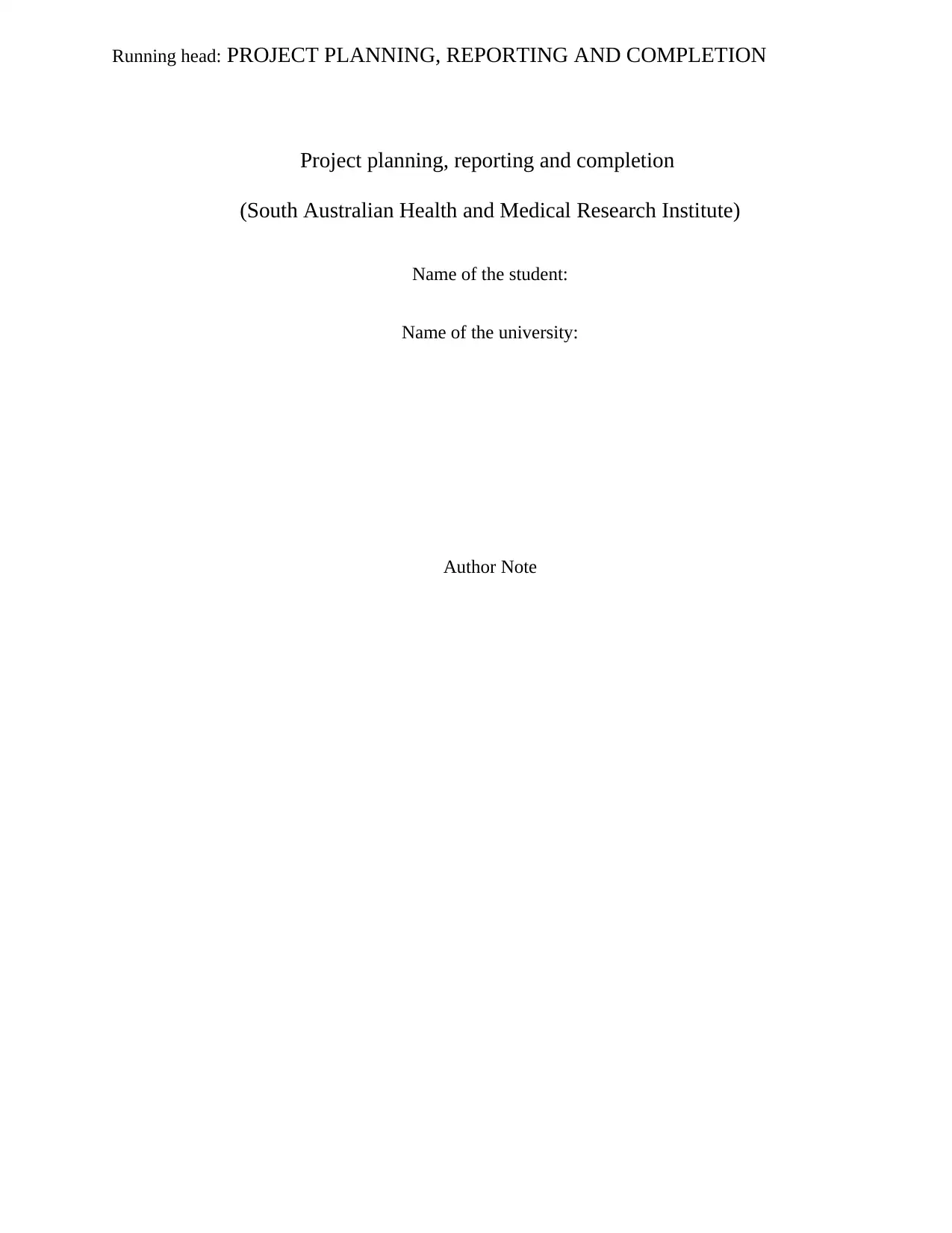
Running head: PROJECT PLANNING, REPORTING AND COMPLETION
Project planning, reporting and completion
(South Australian Health and Medical Research Institute)
Name of the student:
Name of the university:
Author Note
Project planning, reporting and completion
(South Australian Health and Medical Research Institute)
Name of the student:
Name of the university:
Author Note
Secure Best Marks with AI Grader
Need help grading? Try our AI Grader for instant feedback on your assignments.
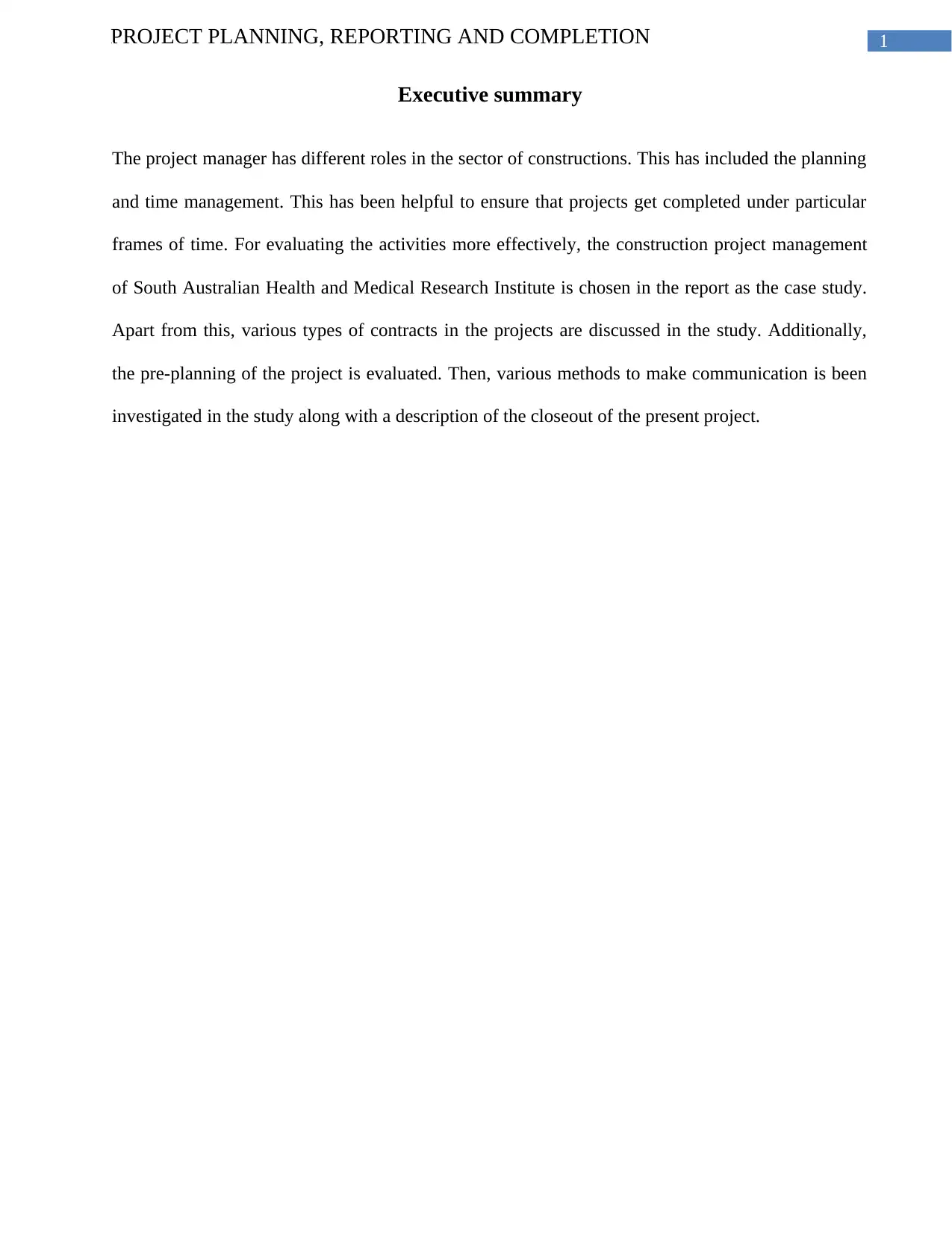
1PROJECT PLANNING, REPORTING AND COMPLETION
Executive summary
The project manager has different roles in the sector of constructions. This has included the planning
and time management. This has been helpful to ensure that projects get completed under particular
frames of time. For evaluating the activities more effectively, the construction project management
of South Australian Health and Medical Research Institute is chosen in the report as the case study.
Apart from this, various types of contracts in the projects are discussed in the study. Additionally,
the pre-planning of the project is evaluated. Then, various methods to make communication is been
investigated in the study along with a description of the closeout of the present project.
Executive summary
The project manager has different roles in the sector of constructions. This has included the planning
and time management. This has been helpful to ensure that projects get completed under particular
frames of time. For evaluating the activities more effectively, the construction project management
of South Australian Health and Medical Research Institute is chosen in the report as the case study.
Apart from this, various types of contracts in the projects are discussed in the study. Additionally,
the pre-planning of the project is evaluated. Then, various methods to make communication is been
investigated in the study along with a description of the closeout of the present project.
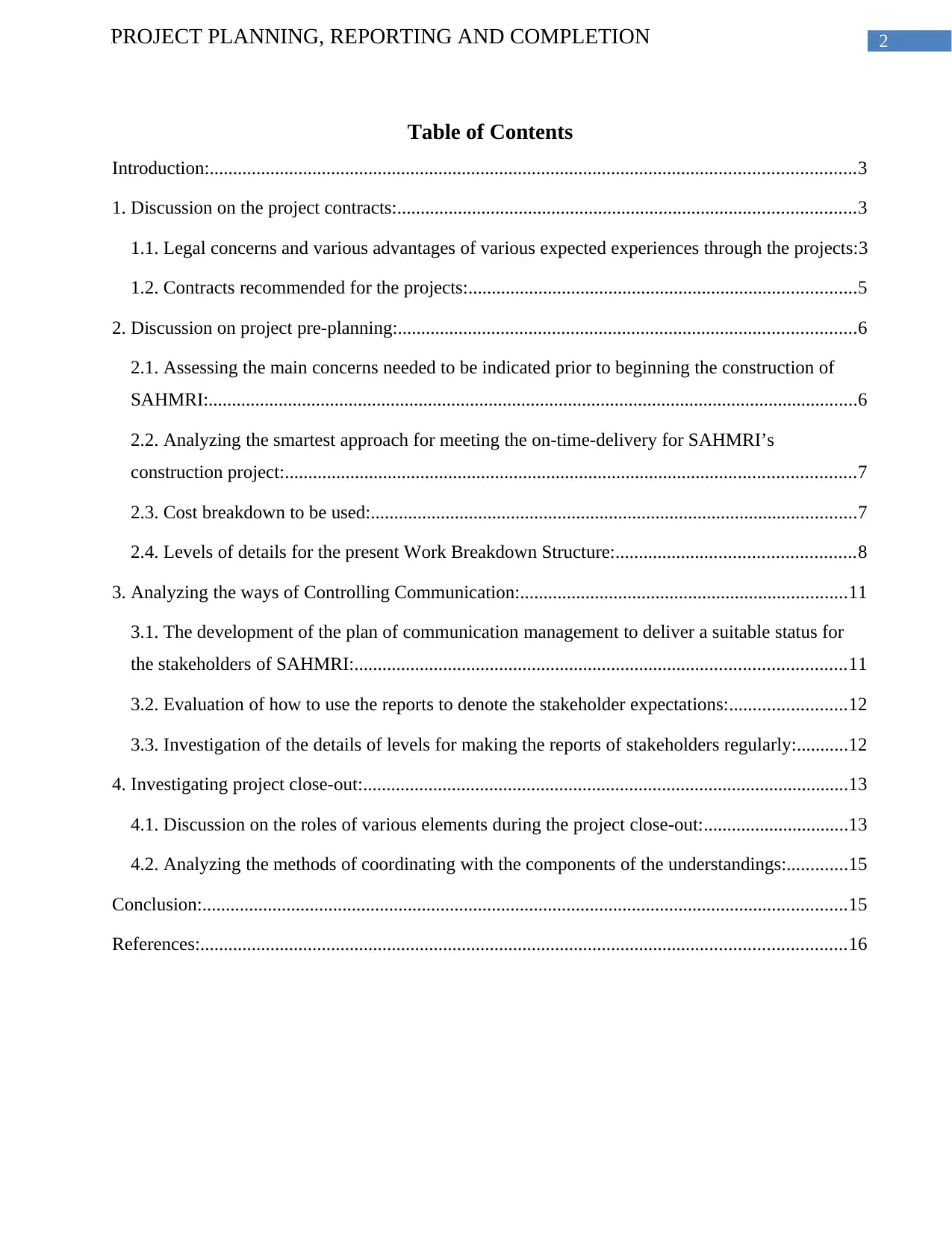
2PROJECT PLANNING, REPORTING AND COMPLETION
Table of Contents
Introduction:..........................................................................................................................................3
1. Discussion on the project contracts:..................................................................................................3
1.1. Legal concerns and various advantages of various expected experiences through the projects:3
1.2. Contracts recommended for the projects:...................................................................................5
2. Discussion on project pre-planning:..................................................................................................6
2.1. Assessing the main concerns needed to be indicated prior to beginning the construction of
SAHMRI:...........................................................................................................................................6
2.2. Analyzing the smartest approach for meeting the on-time-delivery for SAHMRI’s
construction project:..........................................................................................................................7
2.3. Cost breakdown to be used:........................................................................................................7
2.4. Levels of details for the present Work Breakdown Structure:...................................................8
3. Analyzing the ways of Controlling Communication:......................................................................11
3.1. The development of the plan of communication management to deliver a suitable status for
the stakeholders of SAHMRI:.........................................................................................................11
3.2. Evaluation of how to use the reports to denote the stakeholder expectations:.........................12
3.3. Investigation of the details of levels for making the reports of stakeholders regularly:...........12
4. Investigating project close-out:........................................................................................................13
4.1. Discussion on the roles of various elements during the project close-out:...............................13
4.2. Analyzing the methods of coordinating with the components of the understandings:.............15
Conclusion:..........................................................................................................................................15
References:..........................................................................................................................................16
Table of Contents
Introduction:..........................................................................................................................................3
1. Discussion on the project contracts:..................................................................................................3
1.1. Legal concerns and various advantages of various expected experiences through the projects:3
1.2. Contracts recommended for the projects:...................................................................................5
2. Discussion on project pre-planning:..................................................................................................6
2.1. Assessing the main concerns needed to be indicated prior to beginning the construction of
SAHMRI:...........................................................................................................................................6
2.2. Analyzing the smartest approach for meeting the on-time-delivery for SAHMRI’s
construction project:..........................................................................................................................7
2.3. Cost breakdown to be used:........................................................................................................7
2.4. Levels of details for the present Work Breakdown Structure:...................................................8
3. Analyzing the ways of Controlling Communication:......................................................................11
3.1. The development of the plan of communication management to deliver a suitable status for
the stakeholders of SAHMRI:.........................................................................................................11
3.2. Evaluation of how to use the reports to denote the stakeholder expectations:.........................12
3.3. Investigation of the details of levels for making the reports of stakeholders regularly:...........12
4. Investigating project close-out:........................................................................................................13
4.1. Discussion on the roles of various elements during the project close-out:...............................13
4.2. Analyzing the methods of coordinating with the components of the understandings:.............15
Conclusion:..........................................................................................................................................15
References:..........................................................................................................................................16
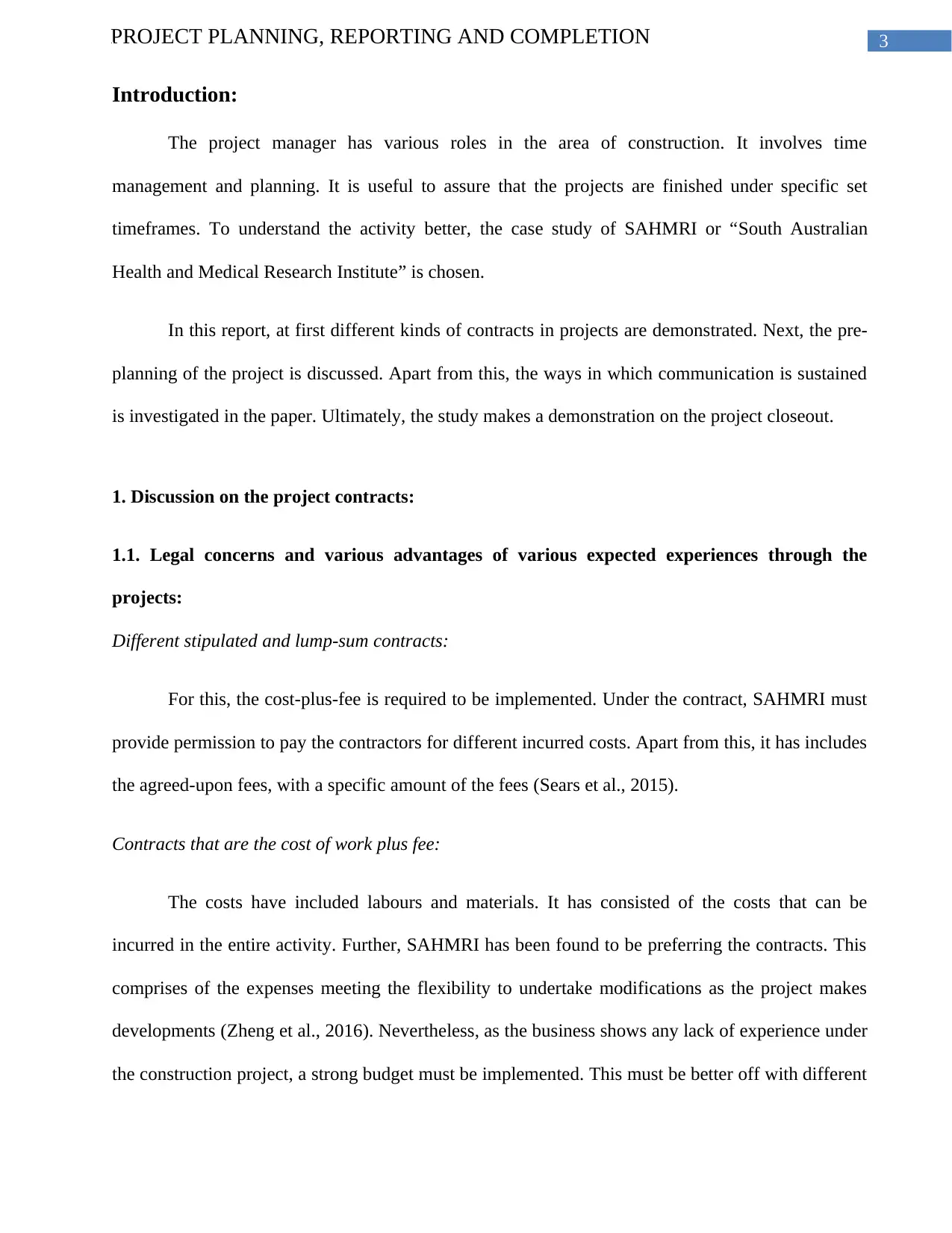
3PROJECT PLANNING, REPORTING AND COMPLETION
Introduction:
The project manager has various roles in the area of construction. It involves time
management and planning. It is useful to assure that the projects are finished under specific set
timeframes. To understand the activity better, the case study of SAHMRI or “South Australian
Health and Medical Research Institute” is chosen.
In this report, at first different kinds of contracts in projects are demonstrated. Next, the pre-
planning of the project is discussed. Apart from this, the ways in which communication is sustained
is investigated in the paper. Ultimately, the study makes a demonstration on the project closeout.
1. Discussion on the project contracts:
1.1. Legal concerns and various advantages of various expected experiences through the
projects:
Different stipulated and lump-sum contracts:
For this, the cost-plus-fee is required to be implemented. Under the contract, SAHMRI must
provide permission to pay the contractors for different incurred costs. Apart from this, it has includes
the agreed-upon fees, with a specific amount of the fees (Sears et al., 2015).
Contracts that are the cost of work plus fee:
The costs have included labours and materials. It has consisted of the costs that can be
incurred in the entire activity. Further, SAHMRI has been found to be preferring the contracts. This
comprises of the expenses meeting the flexibility to undertake modifications as the project makes
developments (Zheng et al., 2016). Nevertheless, as the business shows any lack of experience under
the construction project, a strong budget must be implemented. This must be better off with different
Introduction:
The project manager has various roles in the area of construction. It involves time
management and planning. It is useful to assure that the projects are finished under specific set
timeframes. To understand the activity better, the case study of SAHMRI or “South Australian
Health and Medical Research Institute” is chosen.
In this report, at first different kinds of contracts in projects are demonstrated. Next, the pre-
planning of the project is discussed. Apart from this, the ways in which communication is sustained
is investigated in the paper. Ultimately, the study makes a demonstration on the project closeout.
1. Discussion on the project contracts:
1.1. Legal concerns and various advantages of various expected experiences through the
projects:
Different stipulated and lump-sum contracts:
For this, the cost-plus-fee is required to be implemented. Under the contract, SAHMRI must
provide permission to pay the contractors for different incurred costs. Apart from this, it has includes
the agreed-upon fees, with a specific amount of the fees (Sears et al., 2015).
Contracts that are the cost of work plus fee:
The costs have included labours and materials. It has consisted of the costs that can be
incurred in the entire activity. Further, SAHMRI has been found to be preferring the contracts. This
comprises of the expenses meeting the flexibility to undertake modifications as the project makes
developments (Zheng et al., 2016). Nevertheless, as the business shows any lack of experience under
the construction project, a strong budget must be implemented. This must be better off with different
Secure Best Marks with AI Grader
Need help grading? Try our AI Grader for instant feedback on your assignments.
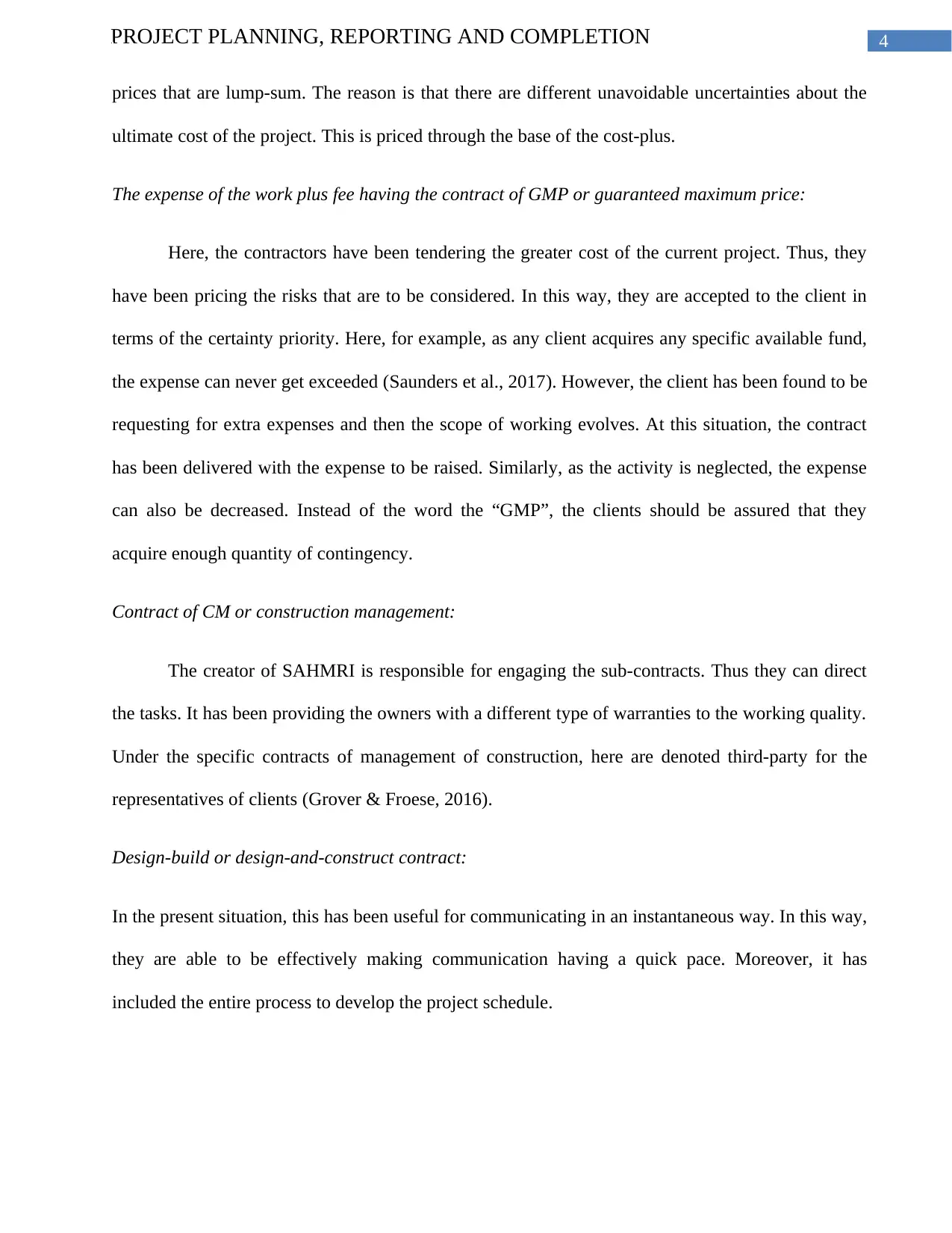
4PROJECT PLANNING, REPORTING AND COMPLETION
prices that are lump-sum. The reason is that there are different unavoidable uncertainties about the
ultimate cost of the project. This is priced through the base of the cost-plus.
The expense of the work plus fee having the contract of GMP or guaranteed maximum price:
Here, the contractors have been tendering the greater cost of the current project. Thus, they
have been pricing the risks that are to be considered. In this way, they are accepted to the client in
terms of the certainty priority. Here, for example, as any client acquires any specific available fund,
the expense can never get exceeded (Saunders et al., 2017). However, the client has been found to be
requesting for extra expenses and then the scope of working evolves. At this situation, the contract
has been delivered with the expense to be raised. Similarly, as the activity is neglected, the expense
can also be decreased. Instead of the word the “GMP”, the clients should be assured that they
acquire enough quantity of contingency.
Contract of CM or construction management:
The creator of SAHMRI is responsible for engaging the sub-contracts. Thus they can direct
the tasks. It has been providing the owners with a different type of warranties to the working quality.
Under the specific contracts of management of construction, here are denoted third-party for the
representatives of clients (Grover & Froese, 2016).
Design-build or design-and-construct contract:
In the present situation, this has been useful for communicating in an instantaneous way. In this way,
they are able to be effectively making communication having a quick pace. Moreover, it has
included the entire process to develop the project schedule.
prices that are lump-sum. The reason is that there are different unavoidable uncertainties about the
ultimate cost of the project. This is priced through the base of the cost-plus.
The expense of the work plus fee having the contract of GMP or guaranteed maximum price:
Here, the contractors have been tendering the greater cost of the current project. Thus, they
have been pricing the risks that are to be considered. In this way, they are accepted to the client in
terms of the certainty priority. Here, for example, as any client acquires any specific available fund,
the expense can never get exceeded (Saunders et al., 2017). However, the client has been found to be
requesting for extra expenses and then the scope of working evolves. At this situation, the contract
has been delivered with the expense to be raised. Similarly, as the activity is neglected, the expense
can also be decreased. Instead of the word the “GMP”, the clients should be assured that they
acquire enough quantity of contingency.
Contract of CM or construction management:
The creator of SAHMRI is responsible for engaging the sub-contracts. Thus they can direct
the tasks. It has been providing the owners with a different type of warranties to the working quality.
Under the specific contracts of management of construction, here are denoted third-party for the
representatives of clients (Grover & Froese, 2016).
Design-build or design-and-construct contract:
In the present situation, this has been useful for communicating in an instantaneous way. In this way,
they are able to be effectively making communication having a quick pace. Moreover, it has
included the entire process to develop the project schedule.
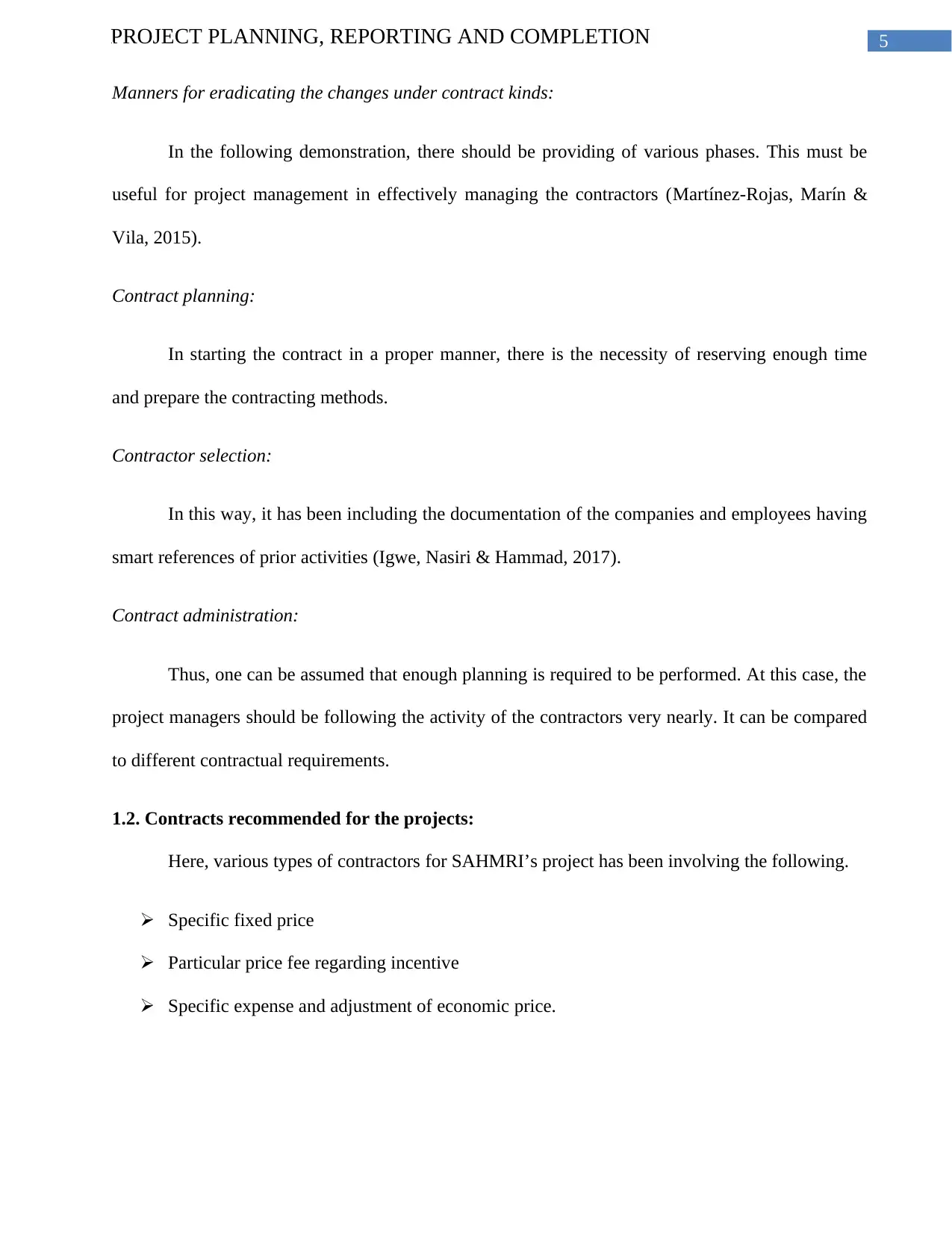
5PROJECT PLANNING, REPORTING AND COMPLETION
Manners for eradicating the changes under contract kinds:
In the following demonstration, there should be providing of various phases. This must be
useful for project management in effectively managing the contractors (Martínez-Rojas, Marín &
Vila, 2015).
Contract planning:
In starting the contract in a proper manner, there is the necessity of reserving enough time
and prepare the contracting methods.
Contractor selection:
In this way, it has been including the documentation of the companies and employees having
smart references of prior activities (Igwe, Nasiri & Hammad, 2017).
Contract administration:
Thus, one can be assumed that enough planning is required to be performed. At this case, the
project managers should be following the activity of the contractors very nearly. It can be compared
to different contractual requirements.
1.2. Contracts recommended for the projects:
Here, various types of contractors for SAHMRI’s project has been involving the following.
Specific fixed price
Particular price fee regarding incentive
Specific expense and adjustment of economic price.
Manners for eradicating the changes under contract kinds:
In the following demonstration, there should be providing of various phases. This must be
useful for project management in effectively managing the contractors (Martínez-Rojas, Marín &
Vila, 2015).
Contract planning:
In starting the contract in a proper manner, there is the necessity of reserving enough time
and prepare the contracting methods.
Contractor selection:
In this way, it has been including the documentation of the companies and employees having
smart references of prior activities (Igwe, Nasiri & Hammad, 2017).
Contract administration:
Thus, one can be assumed that enough planning is required to be performed. At this case, the
project managers should be following the activity of the contractors very nearly. It can be compared
to different contractual requirements.
1.2. Contracts recommended for the projects:
Here, various types of contractors for SAHMRI’s project has been involving the following.
Specific fixed price
Particular price fee regarding incentive
Specific expense and adjustment of economic price.
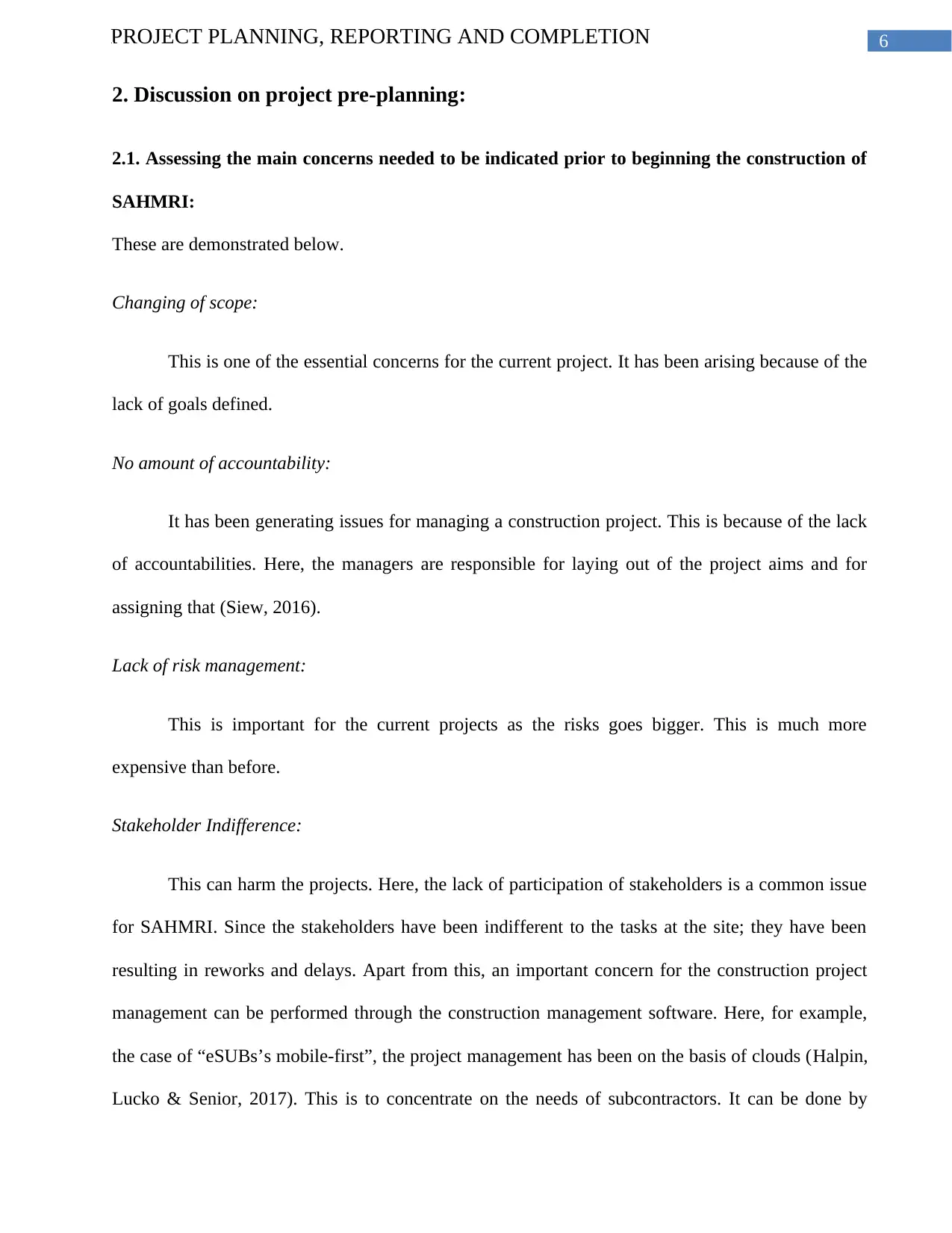
6PROJECT PLANNING, REPORTING AND COMPLETION
2. Discussion on project pre-planning:
2.1. Assessing the main concerns needed to be indicated prior to beginning the construction of
SAHMRI:
These are demonstrated below.
Changing of scope:
This is one of the essential concerns for the current project. It has been arising because of the
lack of goals defined.
No amount of accountability:
It has been generating issues for managing a construction project. This is because of the lack
of accountabilities. Here, the managers are responsible for laying out of the project aims and for
assigning that (Siew, 2016).
Lack of risk management:
This is important for the current projects as the risks goes bigger. This is much more
expensive than before.
Stakeholder Indifference:
This can harm the projects. Here, the lack of participation of stakeholders is a common issue
for SAHMRI. Since the stakeholders have been indifferent to the tasks at the site; they have been
resulting in reworks and delays. Apart from this, an important concern for the construction project
management can be performed through the construction management software. Here, for example,
the case of “eSUBs’s mobile-first”, the project management has been on the basis of clouds (Halpin,
Lucko & Senior, 2017). This is to concentrate on the needs of subcontractors. It can be done by
2. Discussion on project pre-planning:
2.1. Assessing the main concerns needed to be indicated prior to beginning the construction of
SAHMRI:
These are demonstrated below.
Changing of scope:
This is one of the essential concerns for the current project. It has been arising because of the
lack of goals defined.
No amount of accountability:
It has been generating issues for managing a construction project. This is because of the lack
of accountabilities. Here, the managers are responsible for laying out of the project aims and for
assigning that (Siew, 2016).
Lack of risk management:
This is important for the current projects as the risks goes bigger. This is much more
expensive than before.
Stakeholder Indifference:
This can harm the projects. Here, the lack of participation of stakeholders is a common issue
for SAHMRI. Since the stakeholders have been indifferent to the tasks at the site; they have been
resulting in reworks and delays. Apart from this, an important concern for the construction project
management can be performed through the construction management software. Here, for example,
the case of “eSUBs’s mobile-first”, the project management has been on the basis of clouds (Halpin,
Lucko & Senior, 2017). This is to concentrate on the needs of subcontractors. It can be done by
Paraphrase This Document
Need a fresh take? Get an instant paraphrase of this document with our AI Paraphraser
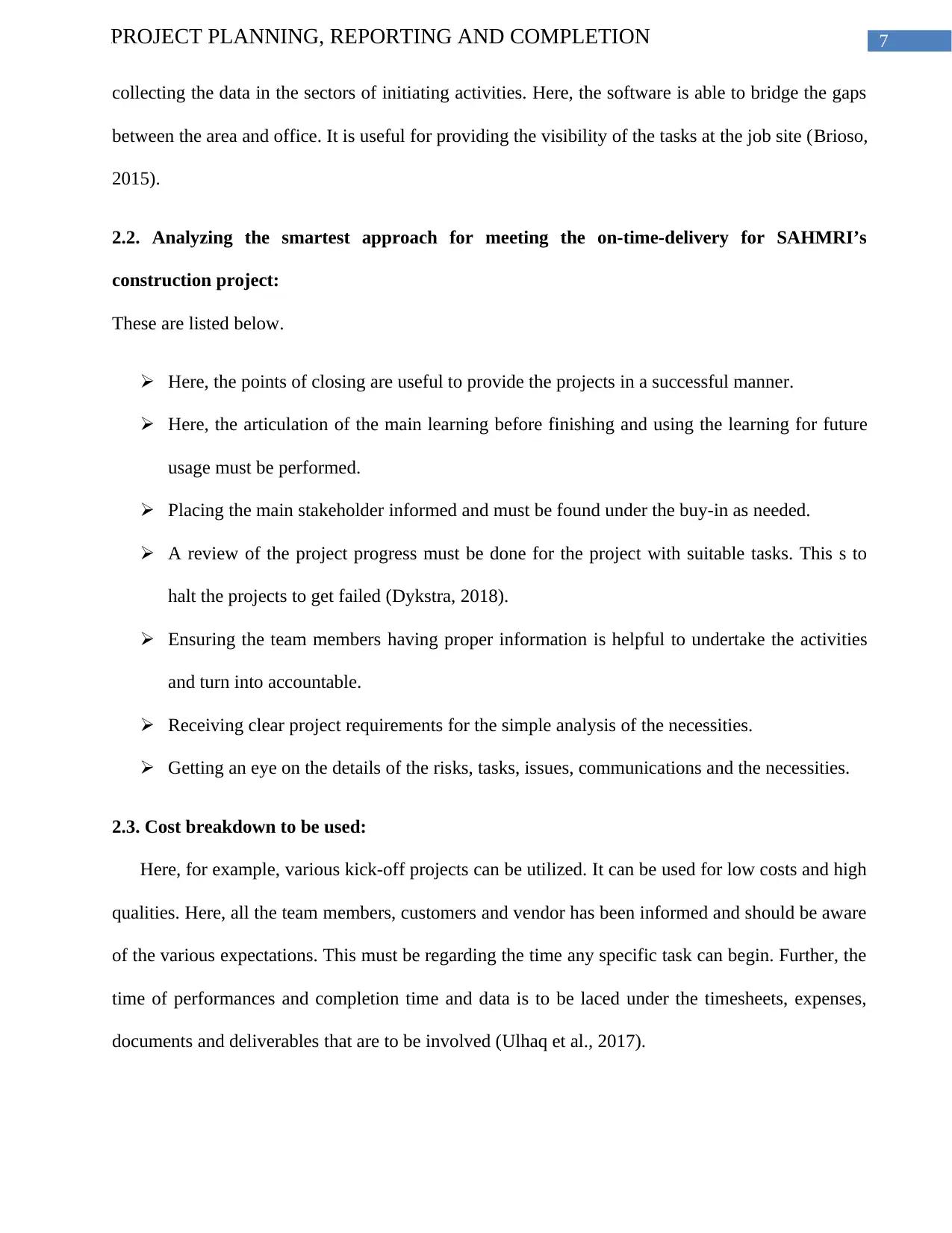
7PROJECT PLANNING, REPORTING AND COMPLETION
collecting the data in the sectors of initiating activities. Here, the software is able to bridge the gaps
between the area and office. It is useful for providing the visibility of the tasks at the job site (Brioso,
2015).
2.2. Analyzing the smartest approach for meeting the on-time-delivery for SAHMRI’s
construction project:
These are listed below.
Here, the points of closing are useful to provide the projects in a successful manner.
Here, the articulation of the main learning before finishing and using the learning for future
usage must be performed.
Placing the main stakeholder informed and must be found under the buy-in as needed.
A review of the project progress must be done for the project with suitable tasks. This s to
halt the projects to get failed (Dykstra, 2018).
Ensuring the team members having proper information is helpful to undertake the activities
and turn into accountable.
Receiving clear project requirements for the simple analysis of the necessities.
Getting an eye on the details of the risks, tasks, issues, communications and the necessities.
2.3. Cost breakdown to be used:
Here, for example, various kick-off projects can be utilized. It can be used for low costs and high
qualities. Here, all the team members, customers and vendor has been informed and should be aware
of the various expectations. This must be regarding the time any specific task can begin. Further, the
time of performances and completion time and data is to be laced under the timesheets, expenses,
documents and deliverables that are to be involved (Ulhaq et al., 2017).
collecting the data in the sectors of initiating activities. Here, the software is able to bridge the gaps
between the area and office. It is useful for providing the visibility of the tasks at the job site (Brioso,
2015).
2.2. Analyzing the smartest approach for meeting the on-time-delivery for SAHMRI’s
construction project:
These are listed below.
Here, the points of closing are useful to provide the projects in a successful manner.
Here, the articulation of the main learning before finishing and using the learning for future
usage must be performed.
Placing the main stakeholder informed and must be found under the buy-in as needed.
A review of the project progress must be done for the project with suitable tasks. This s to
halt the projects to get failed (Dykstra, 2018).
Ensuring the team members having proper information is helpful to undertake the activities
and turn into accountable.
Receiving clear project requirements for the simple analysis of the necessities.
Getting an eye on the details of the risks, tasks, issues, communications and the necessities.
2.3. Cost breakdown to be used:
Here, for example, various kick-off projects can be utilized. It can be used for low costs and high
qualities. Here, all the team members, customers and vendor has been informed and should be aware
of the various expectations. This must be regarding the time any specific task can begin. Further, the
time of performances and completion time and data is to be laced under the timesheets, expenses,
documents and deliverables that are to be involved (Ulhaq et al., 2017).
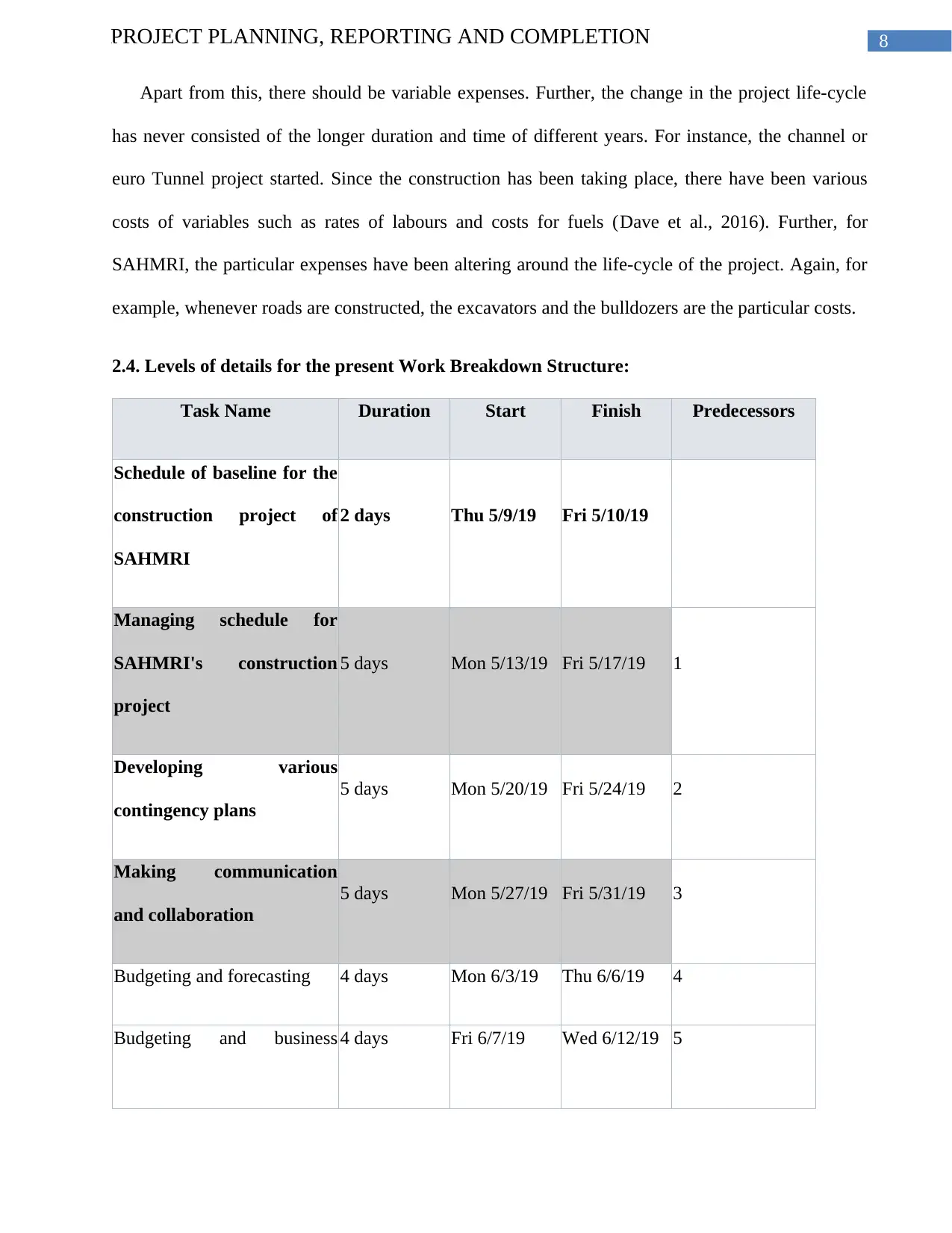
8PROJECT PLANNING, REPORTING AND COMPLETION
Apart from this, there should be variable expenses. Further, the change in the project life-cycle
has never consisted of the longer duration and time of different years. For instance, the channel or
euro Tunnel project started. Since the construction has been taking place, there have been various
costs of variables such as rates of labours and costs for fuels (Dave et al., 2016). Further, for
SAHMRI, the particular expenses have been altering around the life-cycle of the project. Again, for
example, whenever roads are constructed, the excavators and the bulldozers are the particular costs.
2.4. Levels of details for the present Work Breakdown Structure:
Task Name Duration Start Finish Predecessors
Schedule of baseline for the
construction project of
SAHMRI
2 days Thu 5/9/19 Fri 5/10/19
Managing schedule for
SAHMRI's construction
project
5 days Mon 5/13/19 Fri 5/17/19 1
Developing various
contingency plans
5 days Mon 5/20/19 Fri 5/24/19 2
Making communication
and collaboration
5 days Mon 5/27/19 Fri 5/31/19 3
Budgeting and forecasting 4 days Mon 6/3/19 Thu 6/6/19 4
Budgeting and business 4 days Fri 6/7/19 Wed 6/12/19 5
Apart from this, there should be variable expenses. Further, the change in the project life-cycle
has never consisted of the longer duration and time of different years. For instance, the channel or
euro Tunnel project started. Since the construction has been taking place, there have been various
costs of variables such as rates of labours and costs for fuels (Dave et al., 2016). Further, for
SAHMRI, the particular expenses have been altering around the life-cycle of the project. Again, for
example, whenever roads are constructed, the excavators and the bulldozers are the particular costs.
2.4. Levels of details for the present Work Breakdown Structure:
Task Name Duration Start Finish Predecessors
Schedule of baseline for the
construction project of
SAHMRI
2 days Thu 5/9/19 Fri 5/10/19
Managing schedule for
SAHMRI's construction
project
5 days Mon 5/13/19 Fri 5/17/19 1
Developing various
contingency plans
5 days Mon 5/20/19 Fri 5/24/19 2
Making communication
and collaboration
5 days Mon 5/27/19 Fri 5/31/19 3
Budgeting and forecasting 4 days Mon 6/3/19 Thu 6/6/19 4
Budgeting and business 4 days Fri 6/7/19 Wed 6/12/19 5
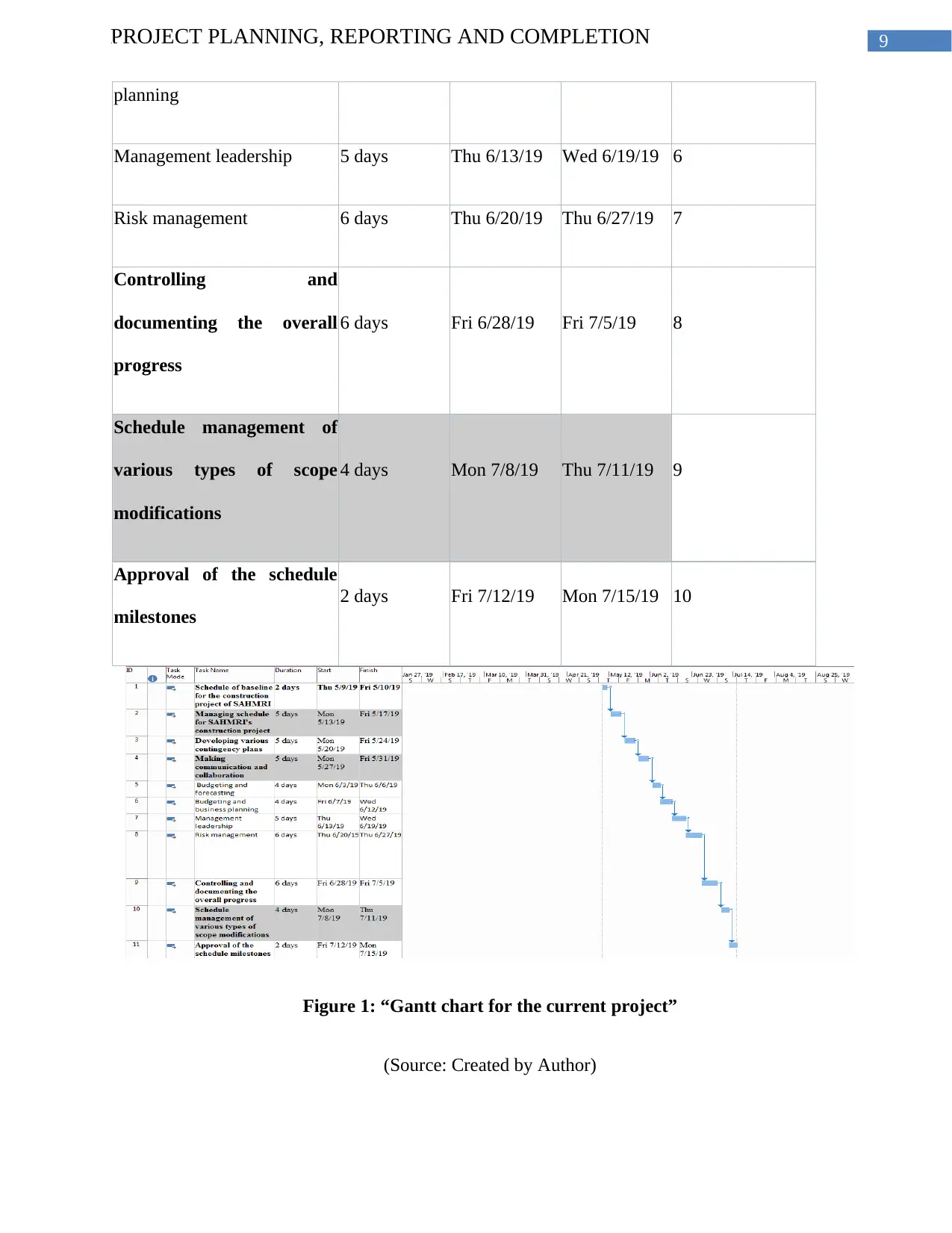
9PROJECT PLANNING, REPORTING AND COMPLETION
planning
Management leadership 5 days Thu 6/13/19 Wed 6/19/19 6
Risk management 6 days Thu 6/20/19 Thu 6/27/19 7
Controlling and
documenting the overall
progress
6 days Fri 6/28/19 Fri 7/5/19 8
Schedule management of
various types of scope
modifications
4 days Mon 7/8/19 Thu 7/11/19 9
Approval of the schedule
milestones
2 days Fri 7/12/19 Mon 7/15/19 10
Figure 1: “Gantt chart for the current project”
(Source: Created by Author)
planning
Management leadership 5 days Thu 6/13/19 Wed 6/19/19 6
Risk management 6 days Thu 6/20/19 Thu 6/27/19 7
Controlling and
documenting the overall
progress
6 days Fri 6/28/19 Fri 7/5/19 8
Schedule management of
various types of scope
modifications
4 days Mon 7/8/19 Thu 7/11/19 9
Approval of the schedule
milestones
2 days Fri 7/12/19 Mon 7/15/19 10
Figure 1: “Gantt chart for the current project”
(Source: Created by Author)
Secure Best Marks with AI Grader
Need help grading? Try our AI Grader for instant feedback on your assignments.
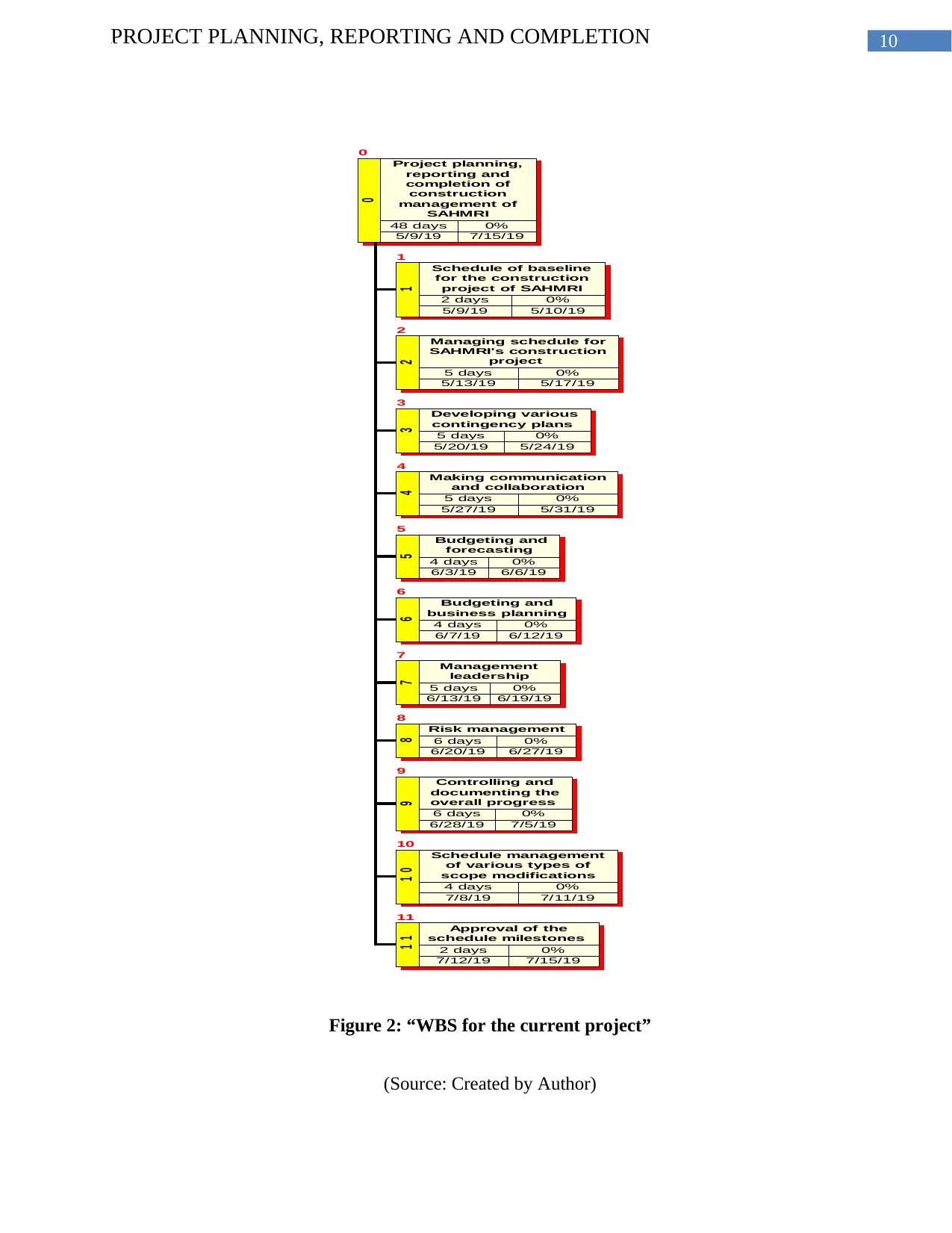
10PROJECT PLANNING, REPORTING AND COMPLETION
0
Project planning,
reporting and
completion of
construction
management of
SAHMRI
1
Schedule of baseline
for the construction
project of SAHMRI
2
Managing schedule for
SAHMRI's construction
project
3
Developing various
contingency plans
4
Making communication
and collaboration
5
Budgeting and
forecasting
6
Budgeting and
business planning
7
Management
leadership
8
Risk management
9
Controlling and
documenting the
overall progress
10
Schedule management
of various types of
scope modifications
11
Approval of the
schedule milestones
0
1234567891 01 1
48 days 0%
5/9/19 7/15/19
2 days 0%
5/9/19 5/10/19
5 days 0%
5/13/19 5/17/19
5 days 0%
5/20/19 5/24/19
5 days 0%
5/27/19 5/31/19
4 days 0%
6/3/19 6/6/19
4 days 0%
6/7/19 6/12/19
5 days 0%
6/13/19 6/19/19
6 days 0%
6/20/19 6/27/19
6 days 0%
6/28/19 7/5/19
4 days 0%
7/8/19 7/11/19
2 days 0%
7/12/19 7/15/19
Figure 2: “WBS for the current project”
(Source: Created by Author)
0
Project planning,
reporting and
completion of
construction
management of
SAHMRI
1
Schedule of baseline
for the construction
project of SAHMRI
2
Managing schedule for
SAHMRI's construction
project
3
Developing various
contingency plans
4
Making communication
and collaboration
5
Budgeting and
forecasting
6
Budgeting and
business planning
7
Management
leadership
8
Risk management
9
Controlling and
documenting the
overall progress
10
Schedule management
of various types of
scope modifications
11
Approval of the
schedule milestones
0
1234567891 01 1
48 days 0%
5/9/19 7/15/19
2 days 0%
5/9/19 5/10/19
5 days 0%
5/13/19 5/17/19
5 days 0%
5/20/19 5/24/19
5 days 0%
5/27/19 5/31/19
4 days 0%
6/3/19 6/6/19
4 days 0%
6/7/19 6/12/19
5 days 0%
6/13/19 6/19/19
6 days 0%
6/20/19 6/27/19
6 days 0%
6/28/19 7/5/19
4 days 0%
7/8/19 7/11/19
2 days 0%
7/12/19 7/15/19
Figure 2: “WBS for the current project”
(Source: Created by Author)
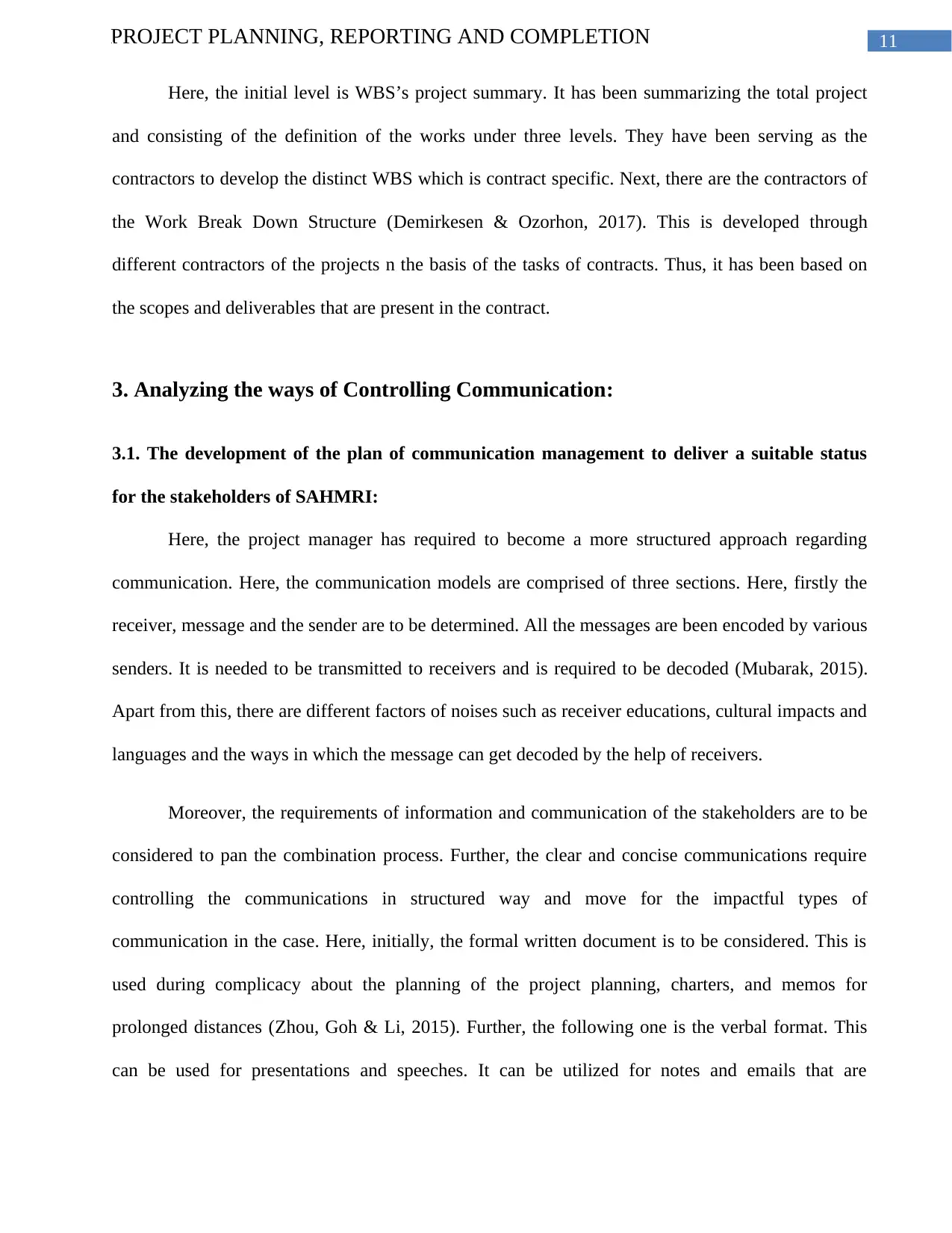
11PROJECT PLANNING, REPORTING AND COMPLETION
Here, the initial level is WBS’s project summary. It has been summarizing the total project
and consisting of the definition of the works under three levels. They have been serving as the
contractors to develop the distinct WBS which is contract specific. Next, there are the contractors of
the Work Break Down Structure (Demirkesen & Ozorhon, 2017). This is developed through
different contractors of the projects n the basis of the tasks of contracts. Thus, it has been based on
the scopes and deliverables that are present in the contract.
3. Analyzing the ways of Controlling Communication:
3.1. The development of the plan of communication management to deliver a suitable status
for the stakeholders of SAHMRI:
Here, the project manager has required to become a more structured approach regarding
communication. Here, the communication models are comprised of three sections. Here, firstly the
receiver, message and the sender are to be determined. All the messages are been encoded by various
senders. It is needed to be transmitted to receivers and is required to be decoded (Mubarak, 2015).
Apart from this, there are different factors of noises such as receiver educations, cultural impacts and
languages and the ways in which the message can get decoded by the help of receivers.
Moreover, the requirements of information and communication of the stakeholders are to be
considered to pan the combination process. Further, the clear and concise communications require
controlling the communications in structured way and move for the impactful types of
communication in the case. Here, initially, the formal written document is to be considered. This is
used during complicacy about the planning of the project planning, charters, and memos for
prolonged distances (Zhou, Goh & Li, 2015). Further, the following one is the verbal format. This
can be used for presentations and speeches. It can be utilized for notes and emails that are
Here, the initial level is WBS’s project summary. It has been summarizing the total project
and consisting of the definition of the works under three levels. They have been serving as the
contractors to develop the distinct WBS which is contract specific. Next, there are the contractors of
the Work Break Down Structure (Demirkesen & Ozorhon, 2017). This is developed through
different contractors of the projects n the basis of the tasks of contracts. Thus, it has been based on
the scopes and deliverables that are present in the contract.
3. Analyzing the ways of Controlling Communication:
3.1. The development of the plan of communication management to deliver a suitable status
for the stakeholders of SAHMRI:
Here, the project manager has required to become a more structured approach regarding
communication. Here, the communication models are comprised of three sections. Here, firstly the
receiver, message and the sender are to be determined. All the messages are been encoded by various
senders. It is needed to be transmitted to receivers and is required to be decoded (Mubarak, 2015).
Apart from this, there are different factors of noises such as receiver educations, cultural impacts and
languages and the ways in which the message can get decoded by the help of receivers.
Moreover, the requirements of information and communication of the stakeholders are to be
considered to pan the combination process. Further, the clear and concise communications require
controlling the communications in structured way and move for the impactful types of
communication in the case. Here, initially, the formal written document is to be considered. This is
used during complicacy about the planning of the project planning, charters, and memos for
prolonged distances (Zhou, Goh & Li, 2015). Further, the following one is the verbal format. This
can be used for presentations and speeches. It can be utilized for notes and emails that are
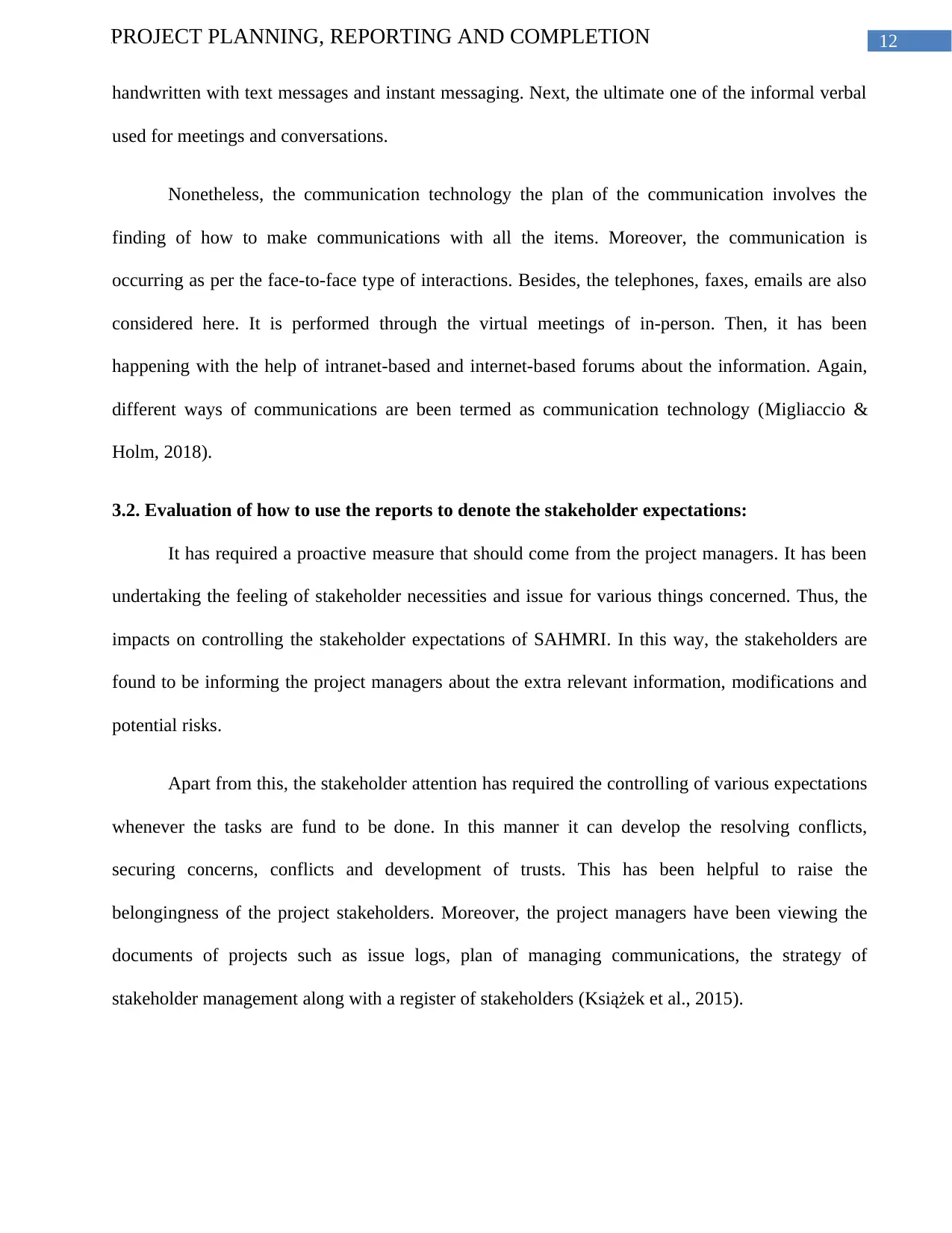
12PROJECT PLANNING, REPORTING AND COMPLETION
handwritten with text messages and instant messaging. Next, the ultimate one of the informal verbal
used for meetings and conversations.
Nonetheless, the communication technology the plan of the communication involves the
finding of how to make communications with all the items. Moreover, the communication is
occurring as per the face-to-face type of interactions. Besides, the telephones, faxes, emails are also
considered here. It is performed through the virtual meetings of in-person. Then, it has been
happening with the help of intranet-based and internet-based forums about the information. Again,
different ways of communications are been termed as communication technology (Migliaccio &
Holm, 2018).
3.2. Evaluation of how to use the reports to denote the stakeholder expectations:
It has required a proactive measure that should come from the project managers. It has been
undertaking the feeling of stakeholder necessities and issue for various things concerned. Thus, the
impacts on controlling the stakeholder expectations of SAHMRI. In this way, the stakeholders are
found to be informing the project managers about the extra relevant information, modifications and
potential risks.
Apart from this, the stakeholder attention has required the controlling of various expectations
whenever the tasks are fund to be done. In this manner it can develop the resolving conflicts,
securing concerns, conflicts and development of trusts. This has been helpful to raise the
belongingness of the project stakeholders. Moreover, the project managers have been viewing the
documents of projects such as issue logs, plan of managing communications, the strategy of
stakeholder management along with a register of stakeholders (Książek et al., 2015).
handwritten with text messages and instant messaging. Next, the ultimate one of the informal verbal
used for meetings and conversations.
Nonetheless, the communication technology the plan of the communication involves the
finding of how to make communications with all the items. Moreover, the communication is
occurring as per the face-to-face type of interactions. Besides, the telephones, faxes, emails are also
considered here. It is performed through the virtual meetings of in-person. Then, it has been
happening with the help of intranet-based and internet-based forums about the information. Again,
different ways of communications are been termed as communication technology (Migliaccio &
Holm, 2018).
3.2. Evaluation of how to use the reports to denote the stakeholder expectations:
It has required a proactive measure that should come from the project managers. It has been
undertaking the feeling of stakeholder necessities and issue for various things concerned. Thus, the
impacts on controlling the stakeholder expectations of SAHMRI. In this way, the stakeholders are
found to be informing the project managers about the extra relevant information, modifications and
potential risks.
Apart from this, the stakeholder attention has required the controlling of various expectations
whenever the tasks are fund to be done. In this manner it can develop the resolving conflicts,
securing concerns, conflicts and development of trusts. This has been helpful to raise the
belongingness of the project stakeholders. Moreover, the project managers have been viewing the
documents of projects such as issue logs, plan of managing communications, the strategy of
stakeholder management along with a register of stakeholders (Książek et al., 2015).
Paraphrase This Document
Need a fresh take? Get an instant paraphrase of this document with our AI Paraphraser
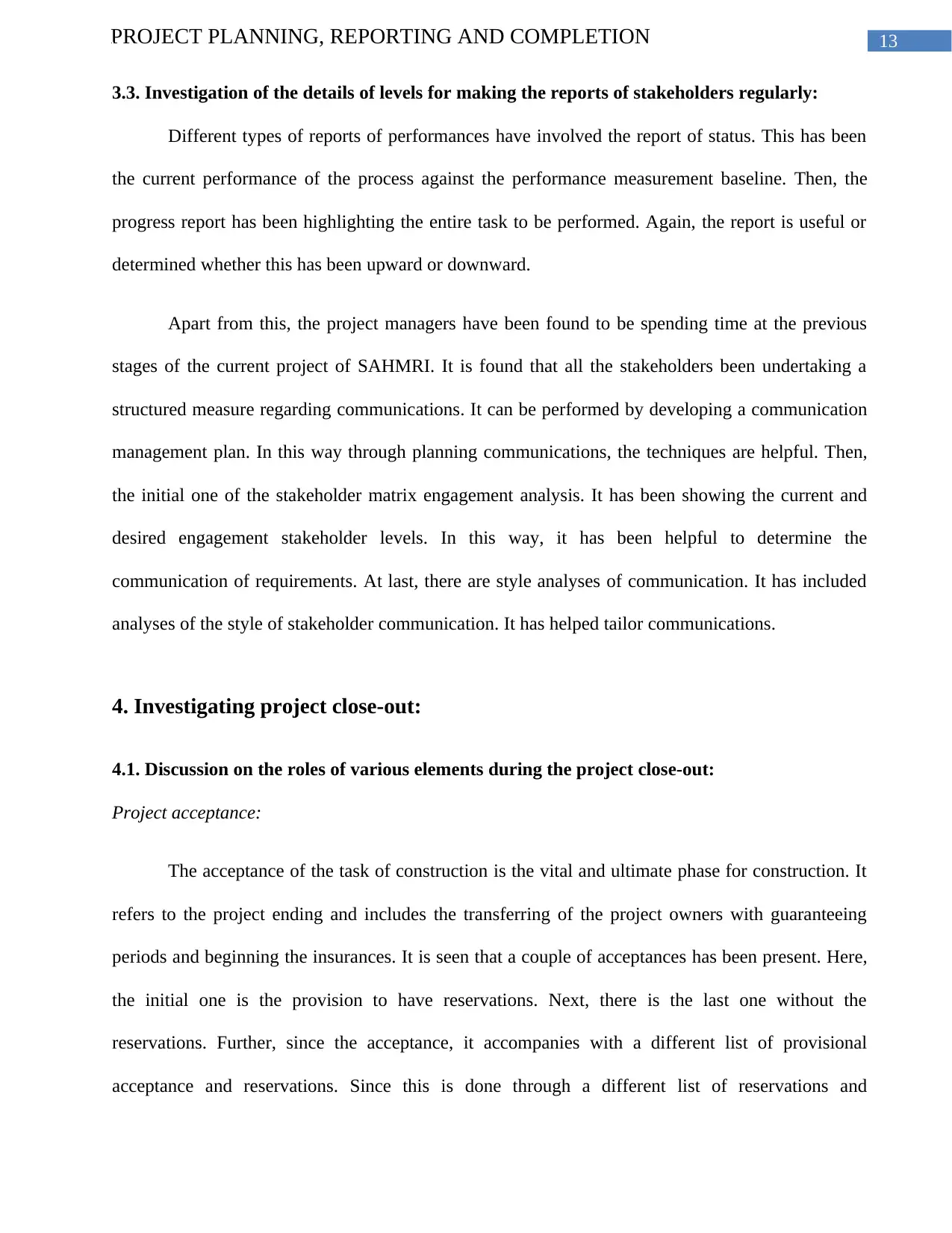
13PROJECT PLANNING, REPORTING AND COMPLETION
3.3. Investigation of the details of levels for making the reports of stakeholders regularly:
Different types of reports of performances have involved the report of status. This has been
the current performance of the process against the performance measurement baseline. Then, the
progress report has been highlighting the entire task to be performed. Again, the report is useful or
determined whether this has been upward or downward.
Apart from this, the project managers have been found to be spending time at the previous
stages of the current project of SAHMRI. It is found that all the stakeholders been undertaking a
structured measure regarding communications. It can be performed by developing a communication
management plan. In this way through planning communications, the techniques are helpful. Then,
the initial one of the stakeholder matrix engagement analysis. It has been showing the current and
desired engagement stakeholder levels. In this way, it has been helpful to determine the
communication of requirements. At last, there are style analyses of communication. It has included
analyses of the style of stakeholder communication. It has helped tailor communications.
4. Investigating project close-out:
4.1. Discussion on the roles of various elements during the project close-out:
Project acceptance:
The acceptance of the task of construction is the vital and ultimate phase for construction. It
refers to the project ending and includes the transferring of the project owners with guaranteeing
periods and beginning the insurances. It is seen that a couple of acceptances has been present. Here,
the initial one is the provision to have reservations. Next, there is the last one without the
reservations. Further, since the acceptance, it accompanies with a different list of provisional
acceptance and reservations. Since this is done through a different list of reservations and
3.3. Investigation of the details of levels for making the reports of stakeholders regularly:
Different types of reports of performances have involved the report of status. This has been
the current performance of the process against the performance measurement baseline. Then, the
progress report has been highlighting the entire task to be performed. Again, the report is useful or
determined whether this has been upward or downward.
Apart from this, the project managers have been found to be spending time at the previous
stages of the current project of SAHMRI. It is found that all the stakeholders been undertaking a
structured measure regarding communications. It can be performed by developing a communication
management plan. In this way through planning communications, the techniques are helpful. Then,
the initial one of the stakeholder matrix engagement analysis. It has been showing the current and
desired engagement stakeholder levels. In this way, it has been helpful to determine the
communication of requirements. At last, there are style analyses of communication. It has included
analyses of the style of stakeholder communication. It has helped tailor communications.
4. Investigating project close-out:
4.1. Discussion on the roles of various elements during the project close-out:
Project acceptance:
The acceptance of the task of construction is the vital and ultimate phase for construction. It
refers to the project ending and includes the transferring of the project owners with guaranteeing
periods and beginning the insurances. It is seen that a couple of acceptances has been present. Here,
the initial one is the provision to have reservations. Next, there is the last one without the
reservations. Further, since the acceptance, it accompanies with a different list of provisional
acceptance and reservations. Since this is done through a different list of reservations and
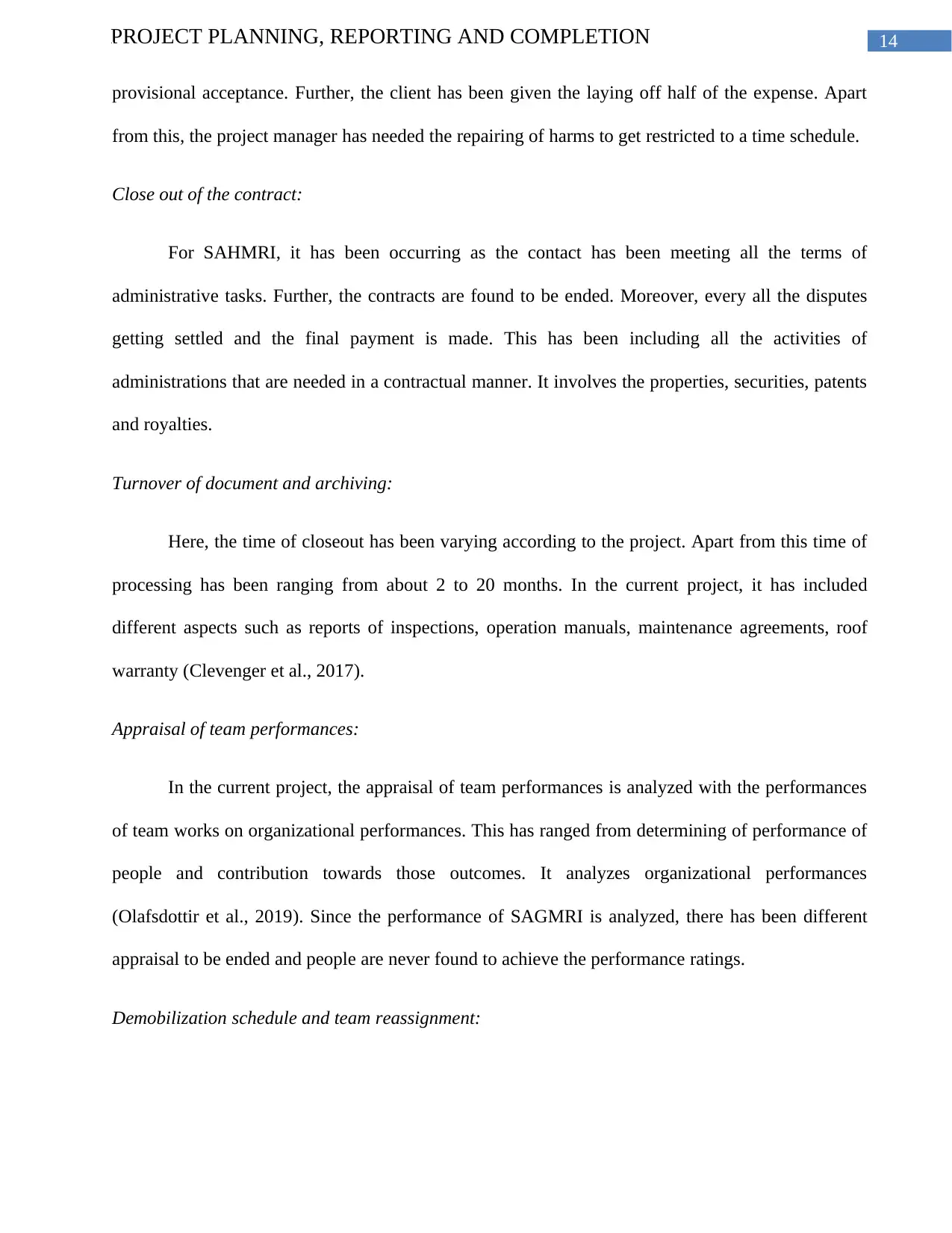
14PROJECT PLANNING, REPORTING AND COMPLETION
provisional acceptance. Further, the client has been given the laying off half of the expense. Apart
from this, the project manager has needed the repairing of harms to get restricted to a time schedule.
Close out of the contract:
For SAHMRI, it has been occurring as the contact has been meeting all the terms of
administrative tasks. Further, the contracts are found to be ended. Moreover, every all the disputes
getting settled and the final payment is made. This has been including all the activities of
administrations that are needed in a contractual manner. It involves the properties, securities, patents
and royalties.
Turnover of document and archiving:
Here, the time of closeout has been varying according to the project. Apart from this time of
processing has been ranging from about 2 to 20 months. In the current project, it has included
different aspects such as reports of inspections, operation manuals, maintenance agreements, roof
warranty (Clevenger et al., 2017).
Appraisal of team performances:
In the current project, the appraisal of team performances is analyzed with the performances
of team works on organizational performances. This has ranged from determining of performance of
people and contribution towards those outcomes. It analyzes organizational performances
(Olafsdottir et al., 2019). Since the performance of SAGMRI is analyzed, there has been different
appraisal to be ended and people are never found to achieve the performance ratings.
Demobilization schedule and team reassignment:
provisional acceptance. Further, the client has been given the laying off half of the expense. Apart
from this, the project manager has needed the repairing of harms to get restricted to a time schedule.
Close out of the contract:
For SAHMRI, it has been occurring as the contact has been meeting all the terms of
administrative tasks. Further, the contracts are found to be ended. Moreover, every all the disputes
getting settled and the final payment is made. This has been including all the activities of
administrations that are needed in a contractual manner. It involves the properties, securities, patents
and royalties.
Turnover of document and archiving:
Here, the time of closeout has been varying according to the project. Apart from this time of
processing has been ranging from about 2 to 20 months. In the current project, it has included
different aspects such as reports of inspections, operation manuals, maintenance agreements, roof
warranty (Clevenger et al., 2017).
Appraisal of team performances:
In the current project, the appraisal of team performances is analyzed with the performances
of team works on organizational performances. This has ranged from determining of performance of
people and contribution towards those outcomes. It analyzes organizational performances
(Olafsdottir et al., 2019). Since the performance of SAGMRI is analyzed, there has been different
appraisal to be ended and people are never found to achieve the performance ratings.
Demobilization schedule and team reassignment:
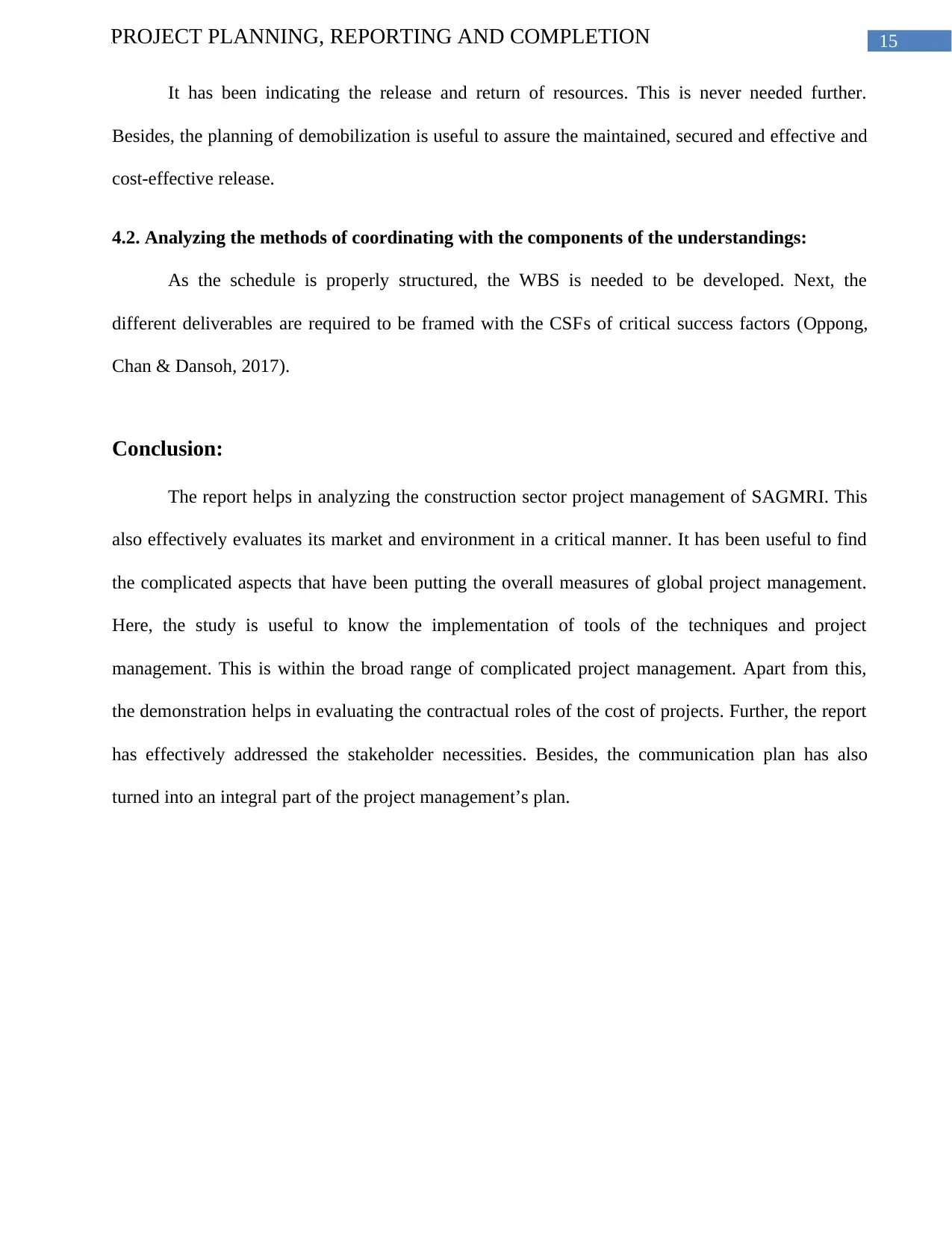
15PROJECT PLANNING, REPORTING AND COMPLETION
It has been indicating the release and return of resources. This is never needed further.
Besides, the planning of demobilization is useful to assure the maintained, secured and effective and
cost-effective release.
4.2. Analyzing the methods of coordinating with the components of the understandings:
As the schedule is properly structured, the WBS is needed to be developed. Next, the
different deliverables are required to be framed with the CSFs of critical success factors (Oppong,
Chan & Dansoh, 2017).
Conclusion:
The report helps in analyzing the construction sector project management of SAGMRI. This
also effectively evaluates its market and environment in a critical manner. It has been useful to find
the complicated aspects that have been putting the overall measures of global project management.
Here, the study is useful to know the implementation of tools of the techniques and project
management. This is within the broad range of complicated project management. Apart from this,
the demonstration helps in evaluating the contractual roles of the cost of projects. Further, the report
has effectively addressed the stakeholder necessities. Besides, the communication plan has also
turned into an integral part of the project management’s plan.
It has been indicating the release and return of resources. This is never needed further.
Besides, the planning of demobilization is useful to assure the maintained, secured and effective and
cost-effective release.
4.2. Analyzing the methods of coordinating with the components of the understandings:
As the schedule is properly structured, the WBS is needed to be developed. Next, the
different deliverables are required to be framed with the CSFs of critical success factors (Oppong,
Chan & Dansoh, 2017).
Conclusion:
The report helps in analyzing the construction sector project management of SAGMRI. This
also effectively evaluates its market and environment in a critical manner. It has been useful to find
the complicated aspects that have been putting the overall measures of global project management.
Here, the study is useful to know the implementation of tools of the techniques and project
management. This is within the broad range of complicated project management. Apart from this,
the demonstration helps in evaluating the contractual roles of the cost of projects. Further, the report
has effectively addressed the stakeholder necessities. Besides, the communication plan has also
turned into an integral part of the project management’s plan.
Secure Best Marks with AI Grader
Need help grading? Try our AI Grader for instant feedback on your assignments.
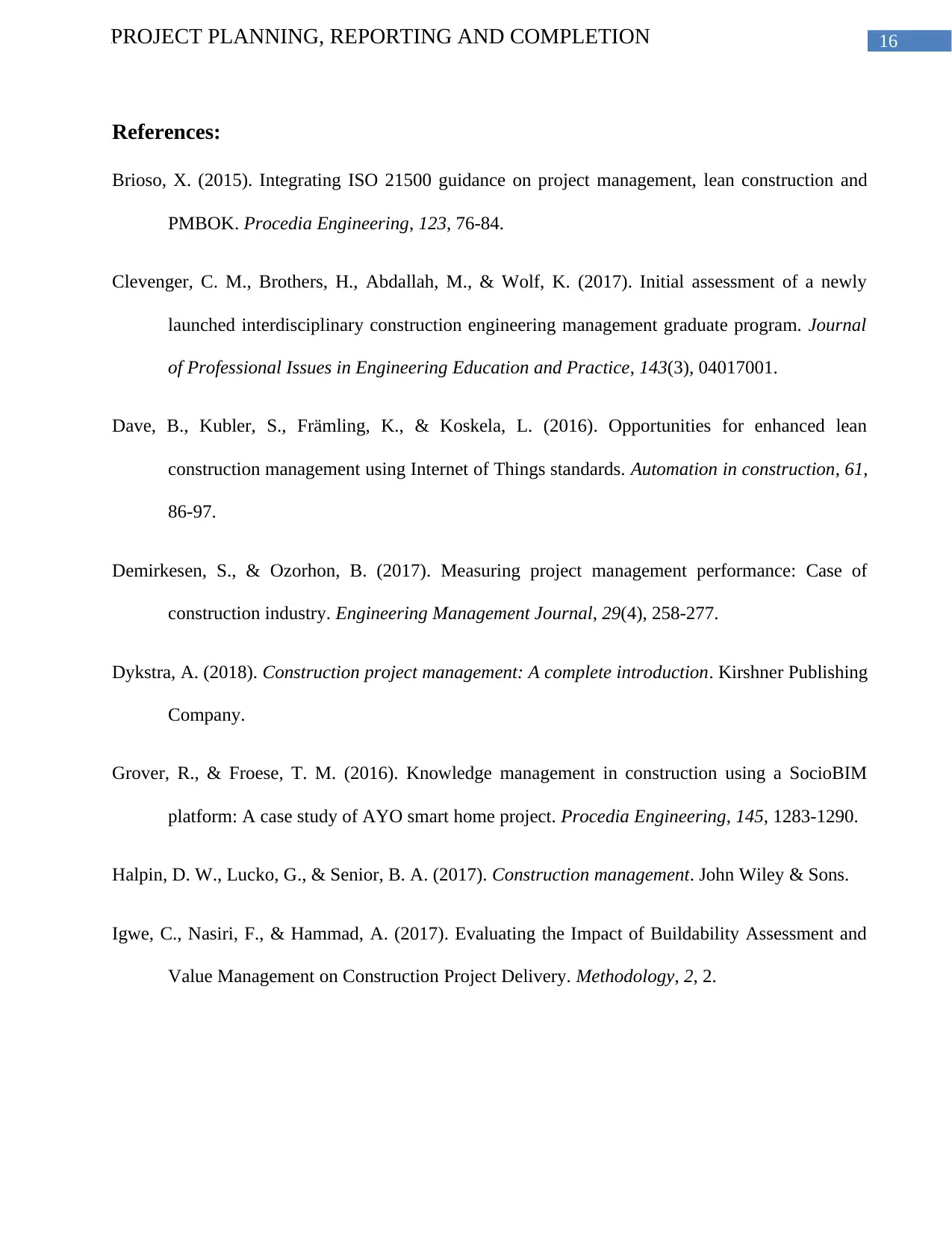
16PROJECT PLANNING, REPORTING AND COMPLETION
References:
Brioso, X. (2015). Integrating ISO 21500 guidance on project management, lean construction and
PMBOK. Procedia Engineering, 123, 76-84.
Clevenger, C. M., Brothers, H., Abdallah, M., & Wolf, K. (2017). Initial assessment of a newly
launched interdisciplinary construction engineering management graduate program. Journal
of Professional Issues in Engineering Education and Practice, 143(3), 04017001.
Dave, B., Kubler, S., Främling, K., & Koskela, L. (2016). Opportunities for enhanced lean
construction management using Internet of Things standards. Automation in construction, 61,
86-97.
Demirkesen, S., & Ozorhon, B. (2017). Measuring project management performance: Case of
construction industry. Engineering Management Journal, 29(4), 258-277.
Dykstra, A. (2018). Construction project management: A complete introduction. Kirshner Publishing
Company.
Grover, R., & Froese, T. M. (2016). Knowledge management in construction using a SocioBIM
platform: A case study of AYO smart home project. Procedia Engineering, 145, 1283-1290.
Halpin, D. W., Lucko, G., & Senior, B. A. (2017). Construction management. John Wiley & Sons.
Igwe, C., Nasiri, F., & Hammad, A. (2017). Evaluating the Impact of Buildability Assessment and
Value Management on Construction Project Delivery. Methodology, 2, 2.
References:
Brioso, X. (2015). Integrating ISO 21500 guidance on project management, lean construction and
PMBOK. Procedia Engineering, 123, 76-84.
Clevenger, C. M., Brothers, H., Abdallah, M., & Wolf, K. (2017). Initial assessment of a newly
launched interdisciplinary construction engineering management graduate program. Journal
of Professional Issues in Engineering Education and Practice, 143(3), 04017001.
Dave, B., Kubler, S., Främling, K., & Koskela, L. (2016). Opportunities for enhanced lean
construction management using Internet of Things standards. Automation in construction, 61,
86-97.
Demirkesen, S., & Ozorhon, B. (2017). Measuring project management performance: Case of
construction industry. Engineering Management Journal, 29(4), 258-277.
Dykstra, A. (2018). Construction project management: A complete introduction. Kirshner Publishing
Company.
Grover, R., & Froese, T. M. (2016). Knowledge management in construction using a SocioBIM
platform: A case study of AYO smart home project. Procedia Engineering, 145, 1283-1290.
Halpin, D. W., Lucko, G., & Senior, B. A. (2017). Construction management. John Wiley & Sons.
Igwe, C., Nasiri, F., & Hammad, A. (2017). Evaluating the Impact of Buildability Assessment and
Value Management on Construction Project Delivery. Methodology, 2, 2.
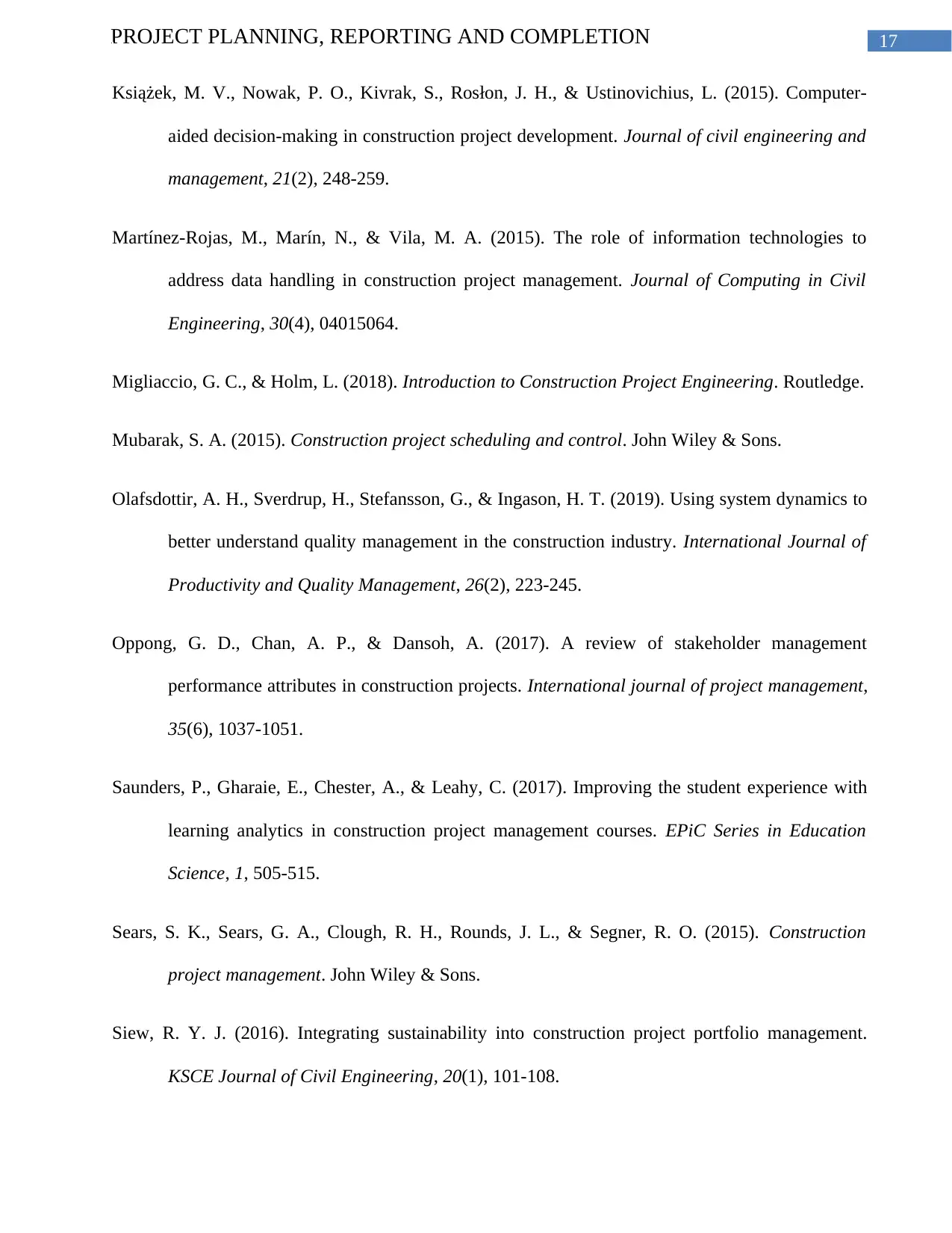
17PROJECT PLANNING, REPORTING AND COMPLETION
Książek, M. V., Nowak, P. O., Kivrak, S., Rosłon, J. H., & Ustinovichius, L. (2015). Computer-
aided decision-making in construction project development. Journal of civil engineering and
management, 21(2), 248-259.
Martínez-Rojas, M., Marín, N., & Vila, M. A. (2015). The role of information technologies to
address data handling in construction project management. Journal of Computing in Civil
Engineering, 30(4), 04015064.
Migliaccio, G. C., & Holm, L. (2018). Introduction to Construction Project Engineering. Routledge.
Mubarak, S. A. (2015). Construction project scheduling and control. John Wiley & Sons.
Olafsdottir, A. H., Sverdrup, H., Stefansson, G., & Ingason, H. T. (2019). Using system dynamics to
better understand quality management in the construction industry. International Journal of
Productivity and Quality Management, 26(2), 223-245.
Oppong, G. D., Chan, A. P., & Dansoh, A. (2017). A review of stakeholder management
performance attributes in construction projects. International journal of project management,
35(6), 1037-1051.
Saunders, P., Gharaie, E., Chester, A., & Leahy, C. (2017). Improving the student experience with
learning analytics in construction project management courses. EPiC Series in Education
Science, 1, 505-515.
Sears, S. K., Sears, G. A., Clough, R. H., Rounds, J. L., & Segner, R. O. (2015). Construction
project management. John Wiley & Sons.
Siew, R. Y. J. (2016). Integrating sustainability into construction project portfolio management.
KSCE Journal of Civil Engineering, 20(1), 101-108.
Książek, M. V., Nowak, P. O., Kivrak, S., Rosłon, J. H., & Ustinovichius, L. (2015). Computer-
aided decision-making in construction project development. Journal of civil engineering and
management, 21(2), 248-259.
Martínez-Rojas, M., Marín, N., & Vila, M. A. (2015). The role of information technologies to
address data handling in construction project management. Journal of Computing in Civil
Engineering, 30(4), 04015064.
Migliaccio, G. C., & Holm, L. (2018). Introduction to Construction Project Engineering. Routledge.
Mubarak, S. A. (2015). Construction project scheduling and control. John Wiley & Sons.
Olafsdottir, A. H., Sverdrup, H., Stefansson, G., & Ingason, H. T. (2019). Using system dynamics to
better understand quality management in the construction industry. International Journal of
Productivity and Quality Management, 26(2), 223-245.
Oppong, G. D., Chan, A. P., & Dansoh, A. (2017). A review of stakeholder management
performance attributes in construction projects. International journal of project management,
35(6), 1037-1051.
Saunders, P., Gharaie, E., Chester, A., & Leahy, C. (2017). Improving the student experience with
learning analytics in construction project management courses. EPiC Series in Education
Science, 1, 505-515.
Sears, S. K., Sears, G. A., Clough, R. H., Rounds, J. L., & Segner, R. O. (2015). Construction
project management. John Wiley & Sons.
Siew, R. Y. J. (2016). Integrating sustainability into construction project portfolio management.
KSCE Journal of Civil Engineering, 20(1), 101-108.
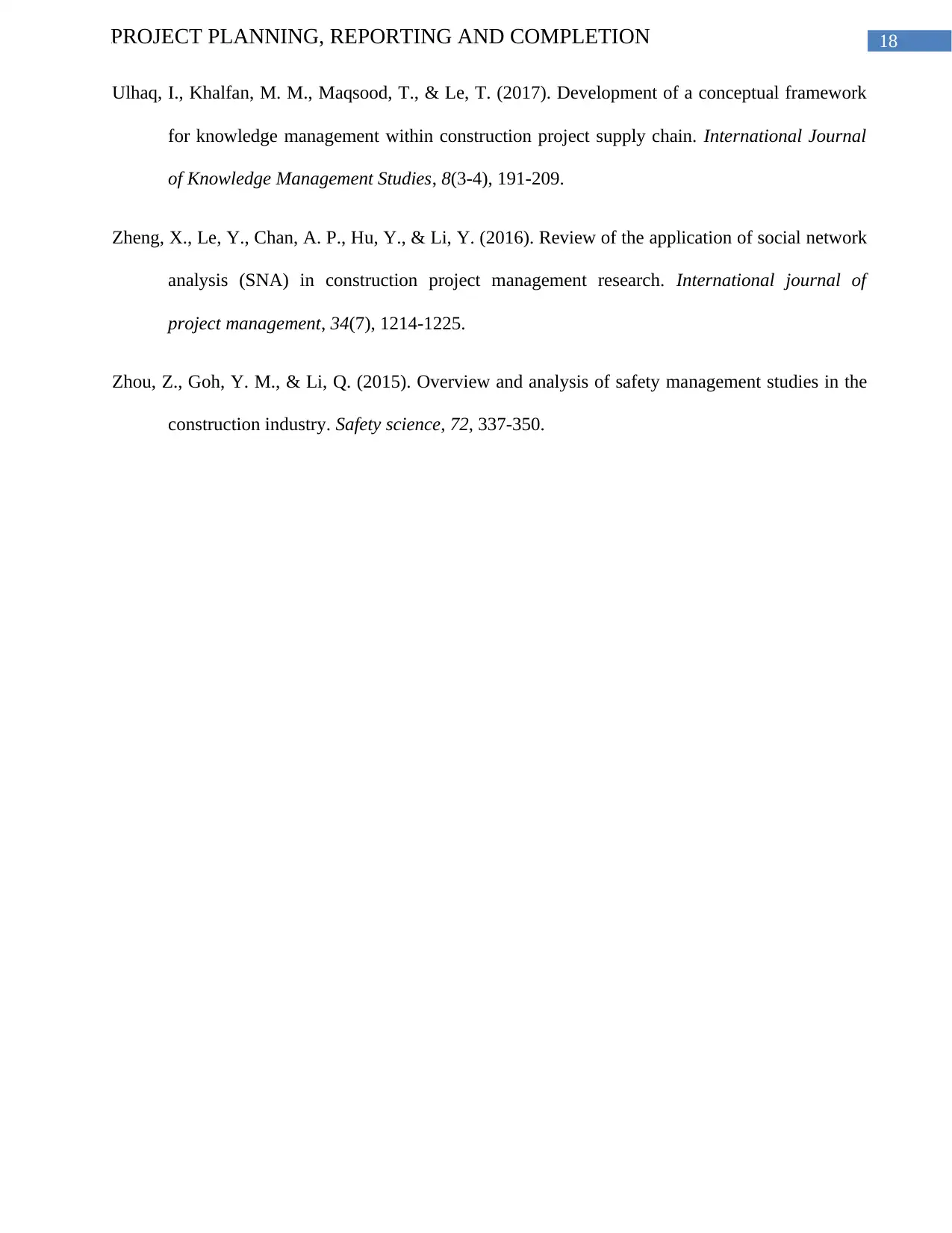
18PROJECT PLANNING, REPORTING AND COMPLETION
Ulhaq, I., Khalfan, M. M., Maqsood, T., & Le, T. (2017). Development of a conceptual framework
for knowledge management within construction project supply chain. International Journal
of Knowledge Management Studies, 8(3-4), 191-209.
Zheng, X., Le, Y., Chan, A. P., Hu, Y., & Li, Y. (2016). Review of the application of social network
analysis (SNA) in construction project management research. International journal of
project management, 34(7), 1214-1225.
Zhou, Z., Goh, Y. M., & Li, Q. (2015). Overview and analysis of safety management studies in the
construction industry. Safety science, 72, 337-350.
Ulhaq, I., Khalfan, M. M., Maqsood, T., & Le, T. (2017). Development of a conceptual framework
for knowledge management within construction project supply chain. International Journal
of Knowledge Management Studies, 8(3-4), 191-209.
Zheng, X., Le, Y., Chan, A. P., Hu, Y., & Li, Y. (2016). Review of the application of social network
analysis (SNA) in construction project management research. International journal of
project management, 34(7), 1214-1225.
Zhou, Z., Goh, Y. M., & Li, Q. (2015). Overview and analysis of safety management studies in the
construction industry. Safety science, 72, 337-350.
1 out of 19
Related Documents
Your All-in-One AI-Powered Toolkit for Academic Success.
+13062052269
info@desklib.com
Available 24*7 on WhatsApp / Email
![[object Object]](/_next/static/media/star-bottom.7253800d.svg)
Unlock your academic potential
© 2024 | Zucol Services PVT LTD | All rights reserved.





